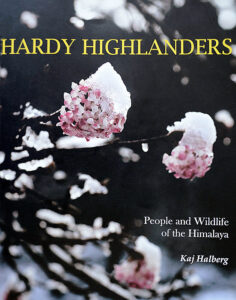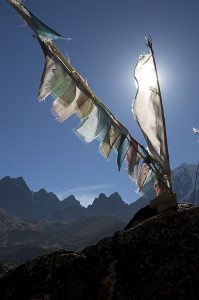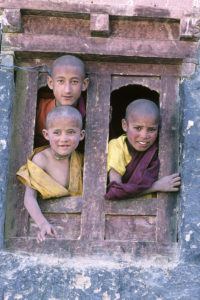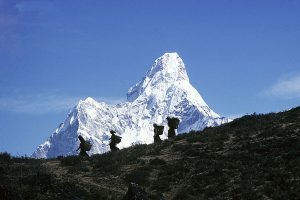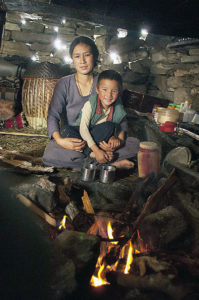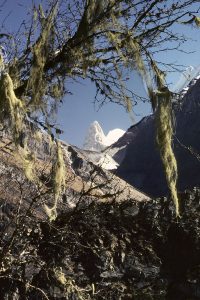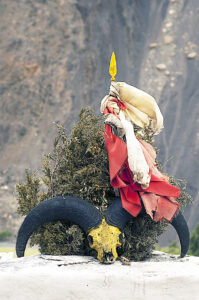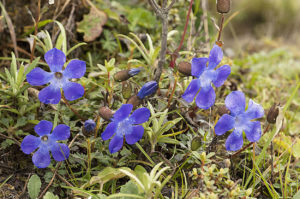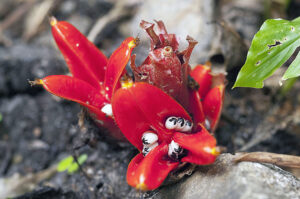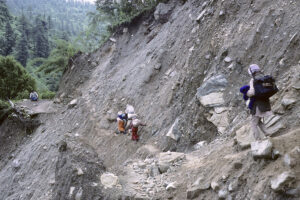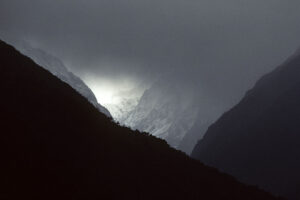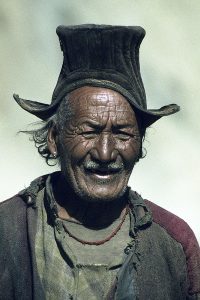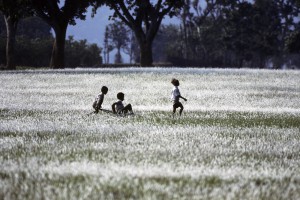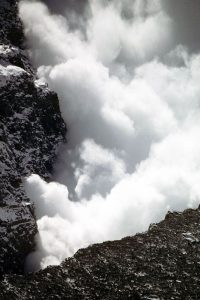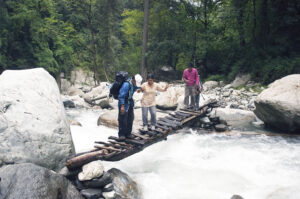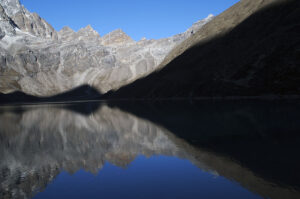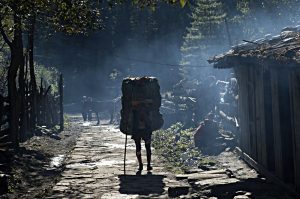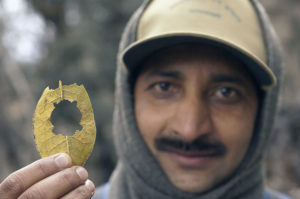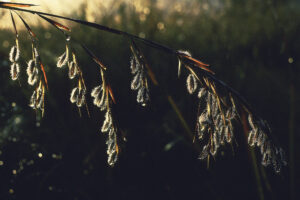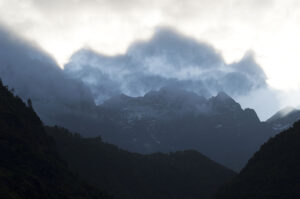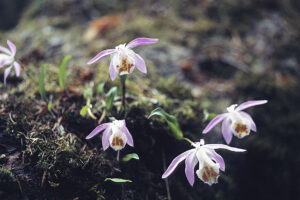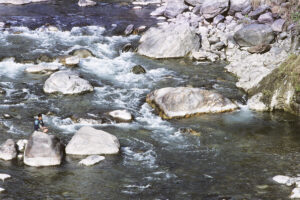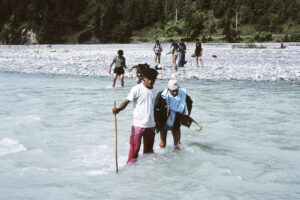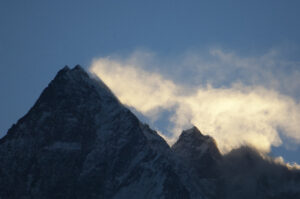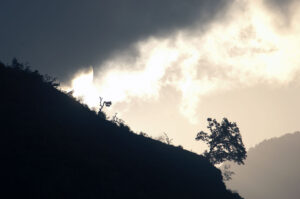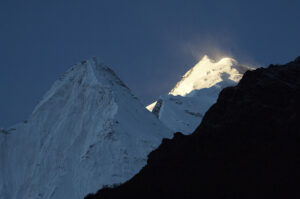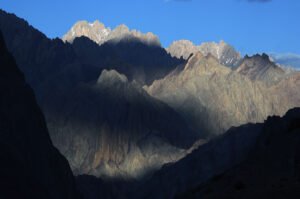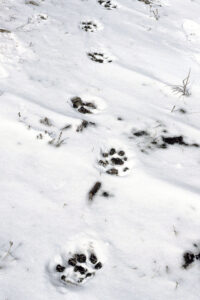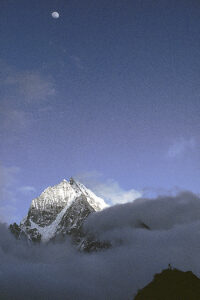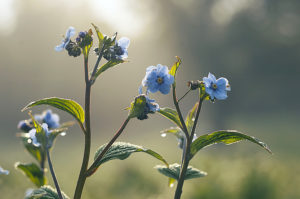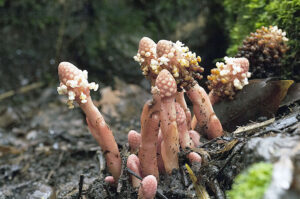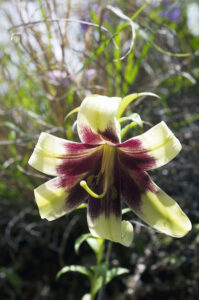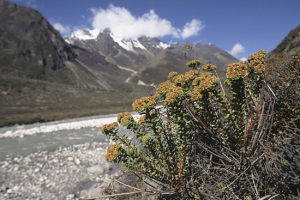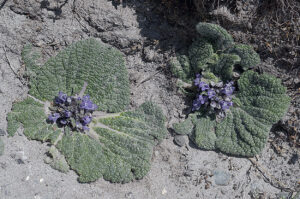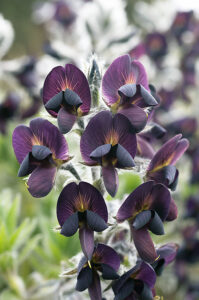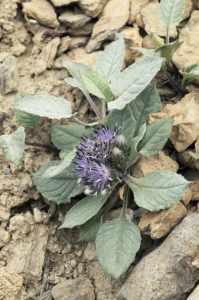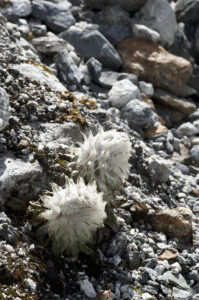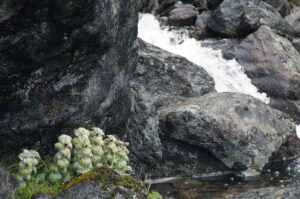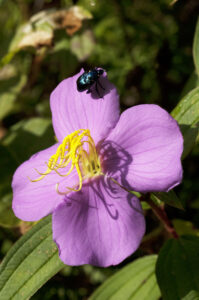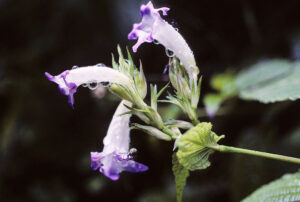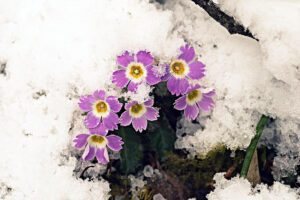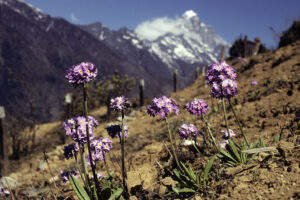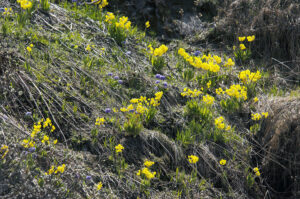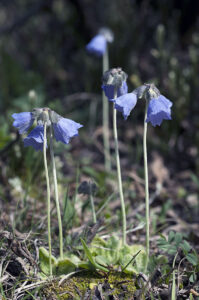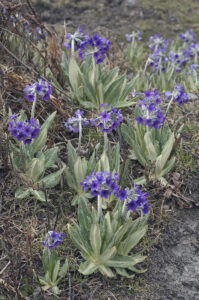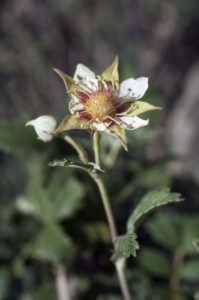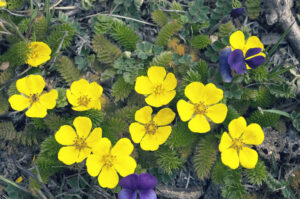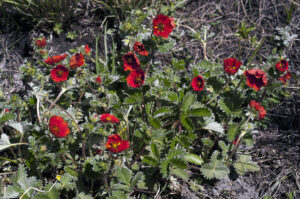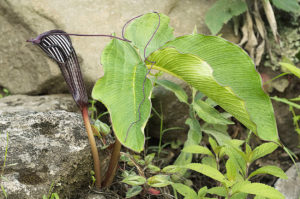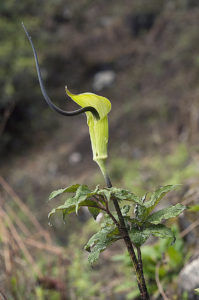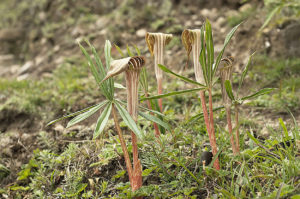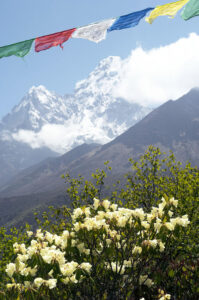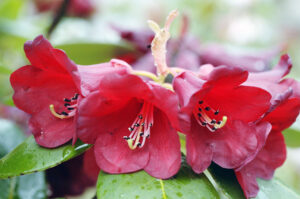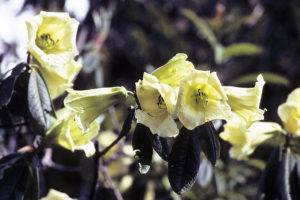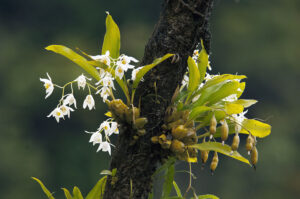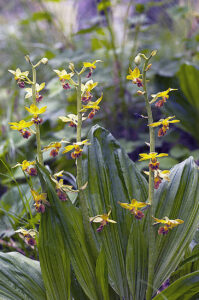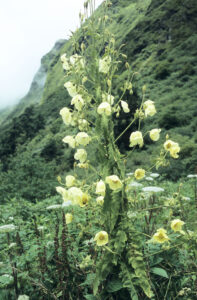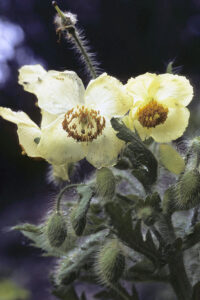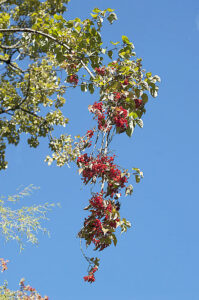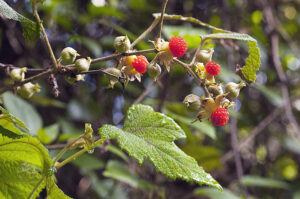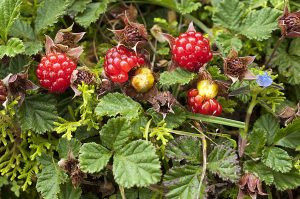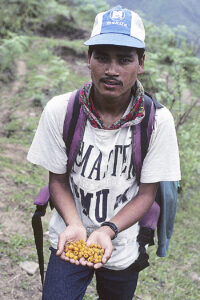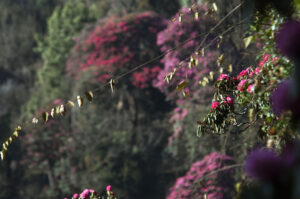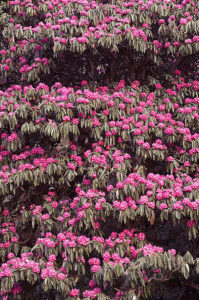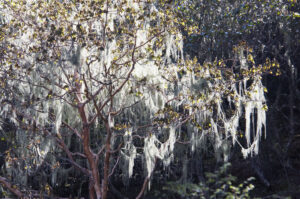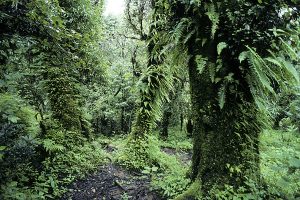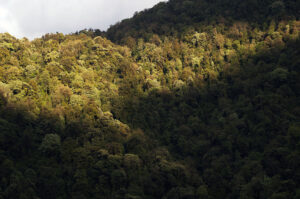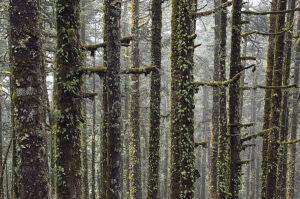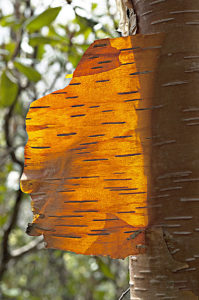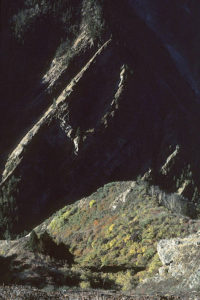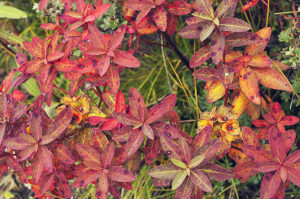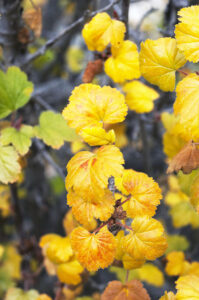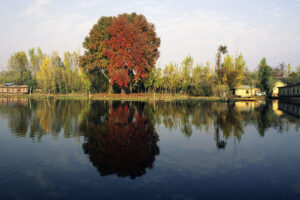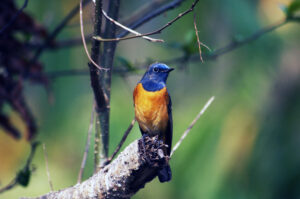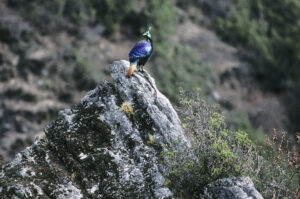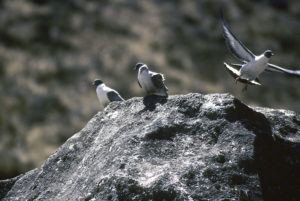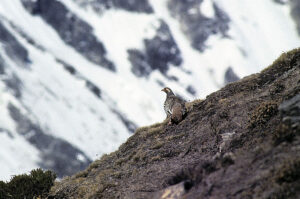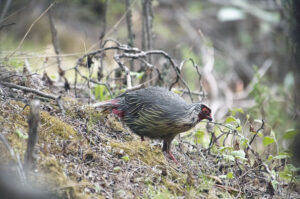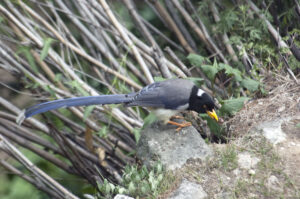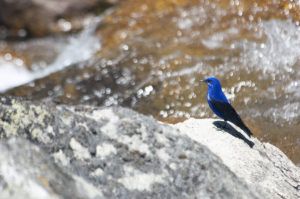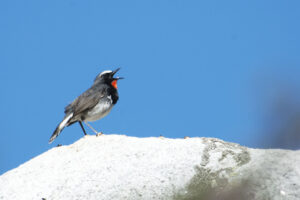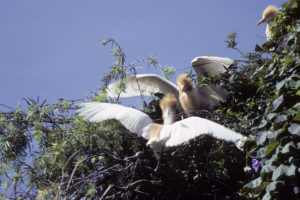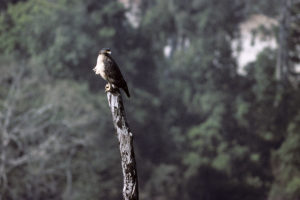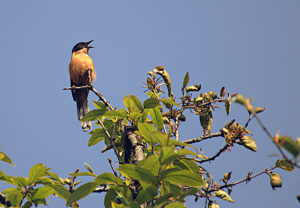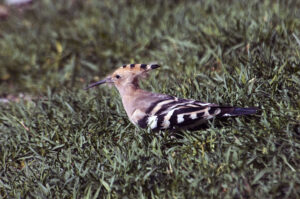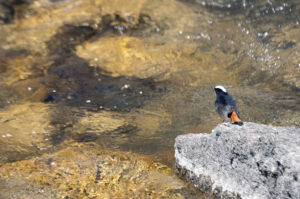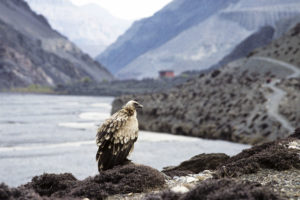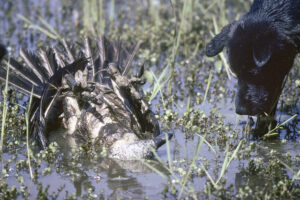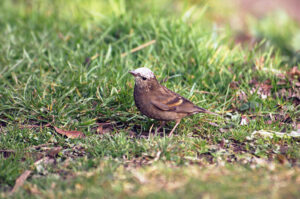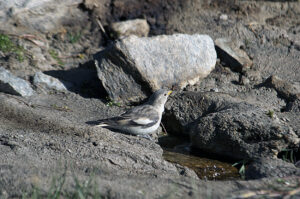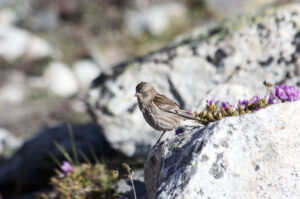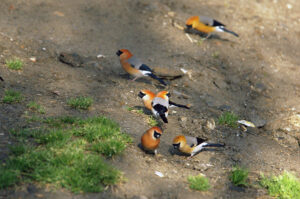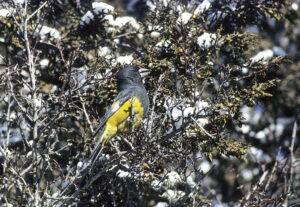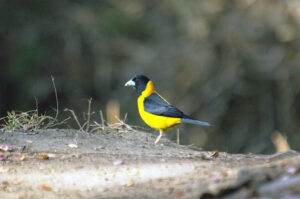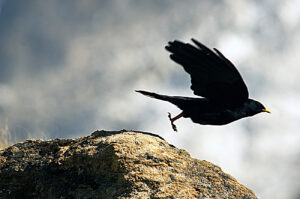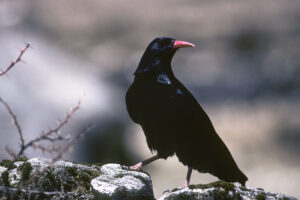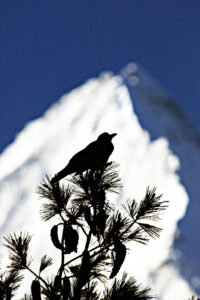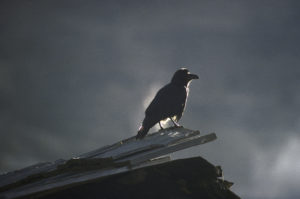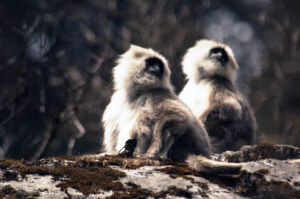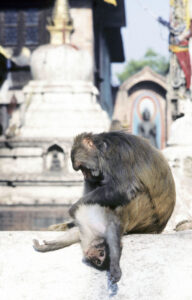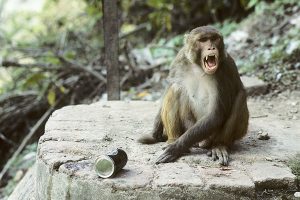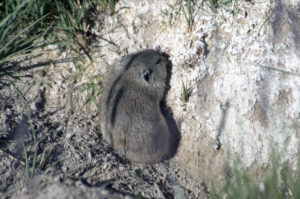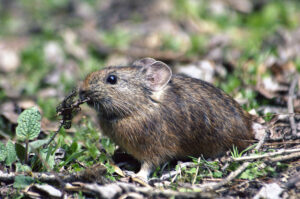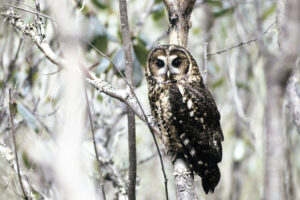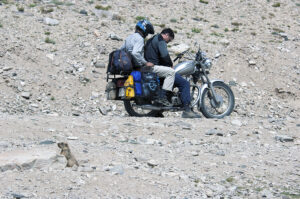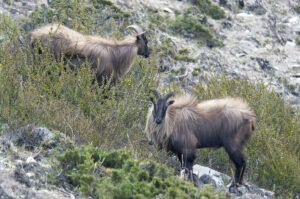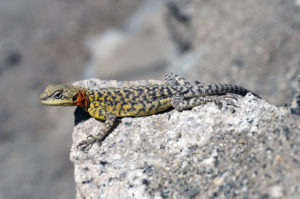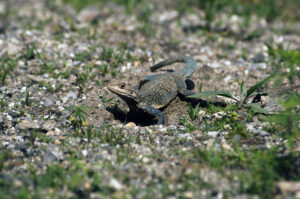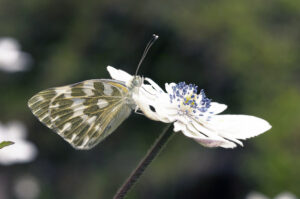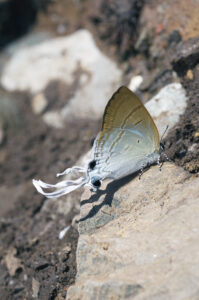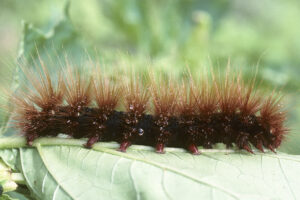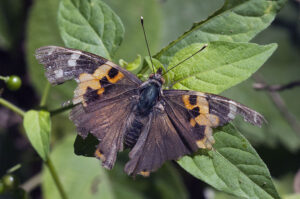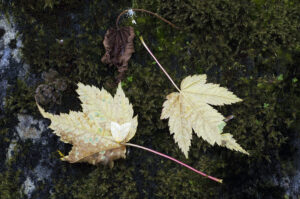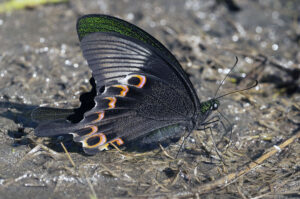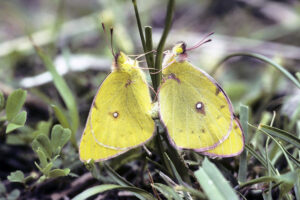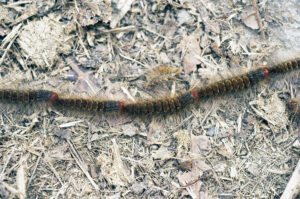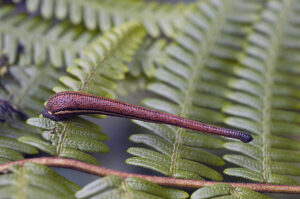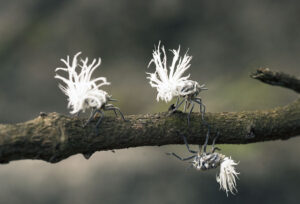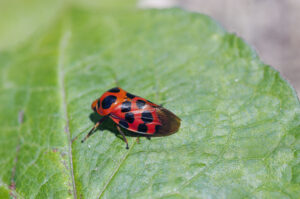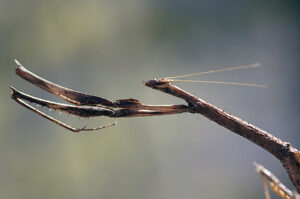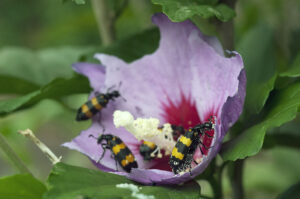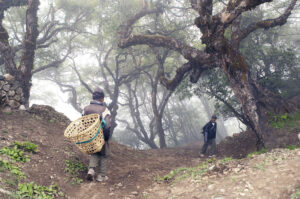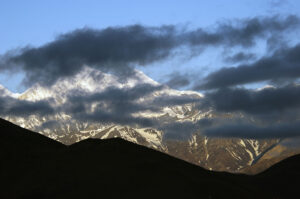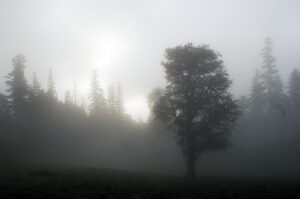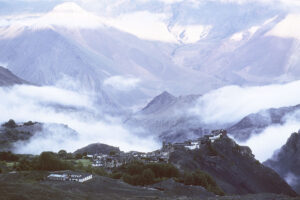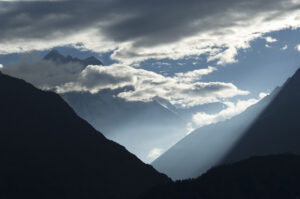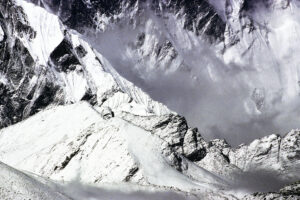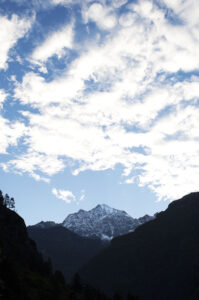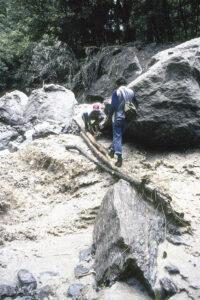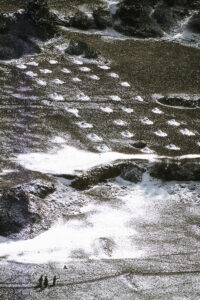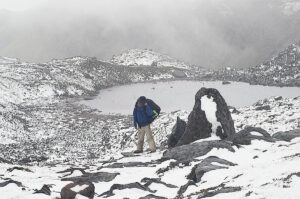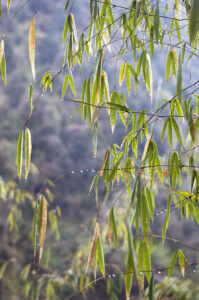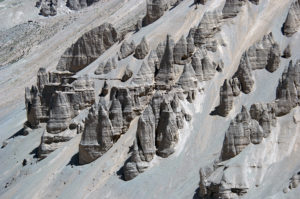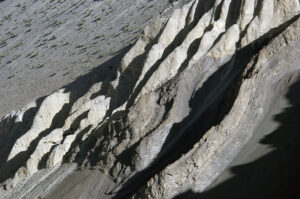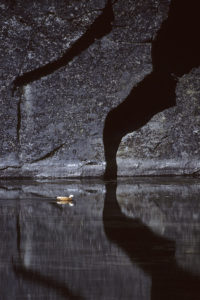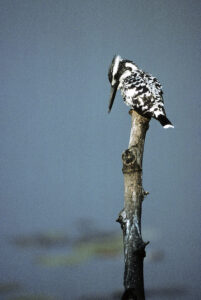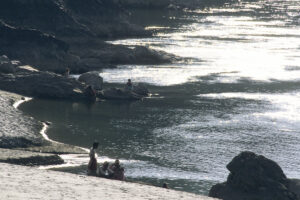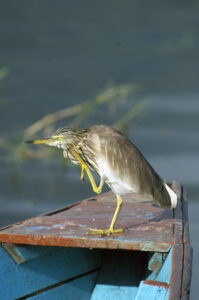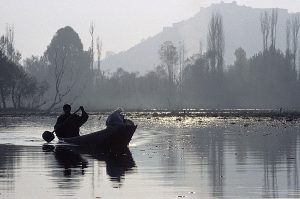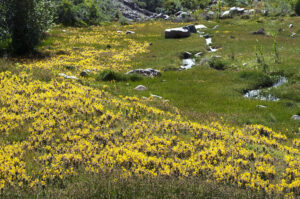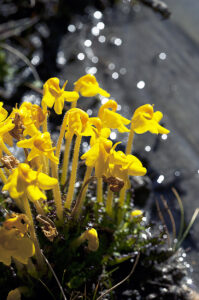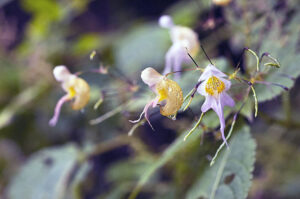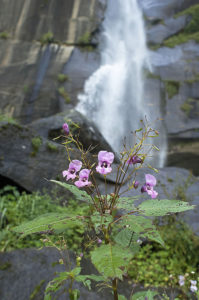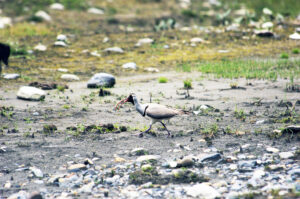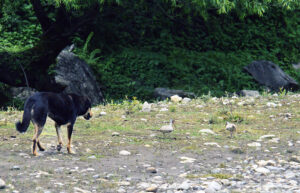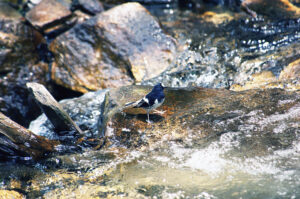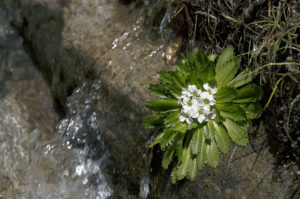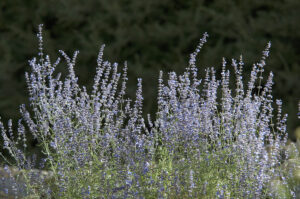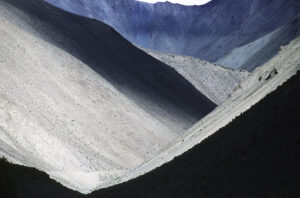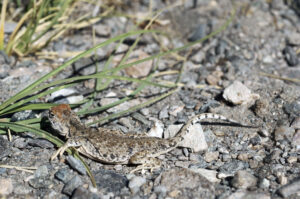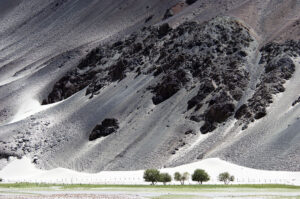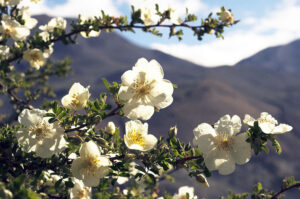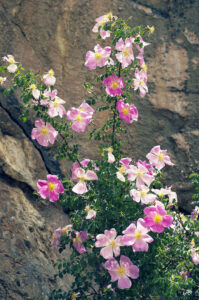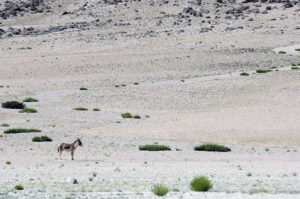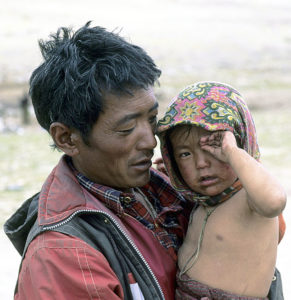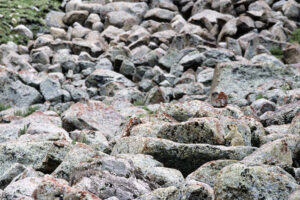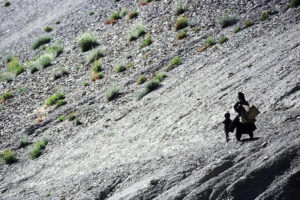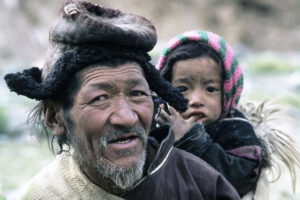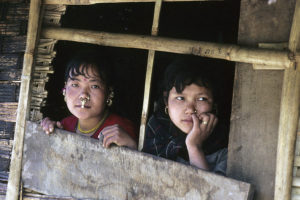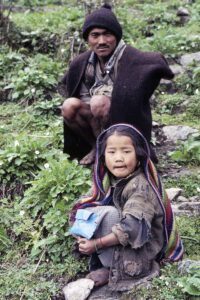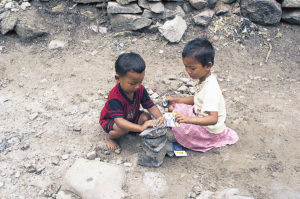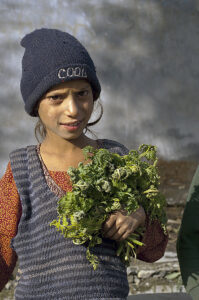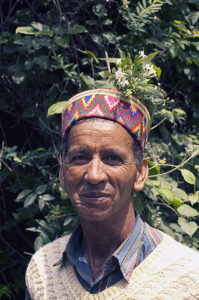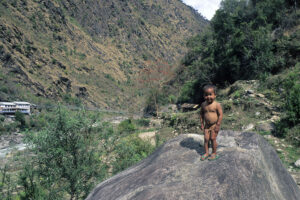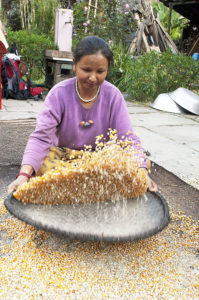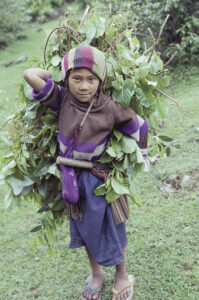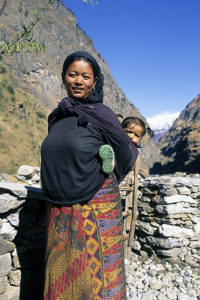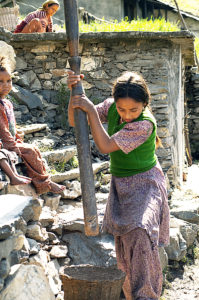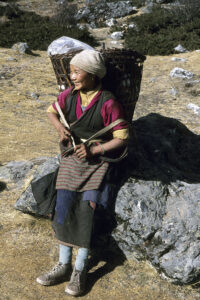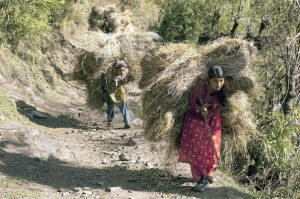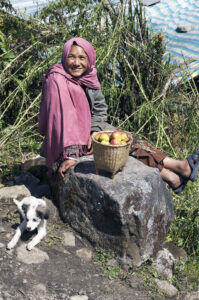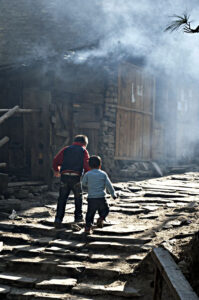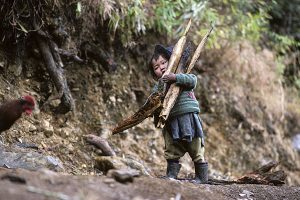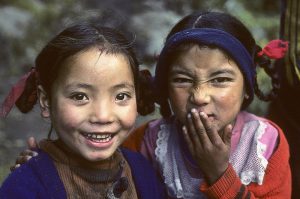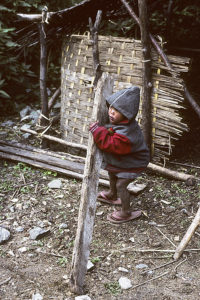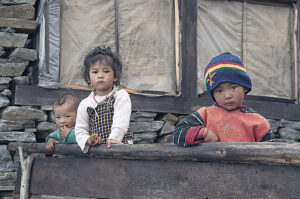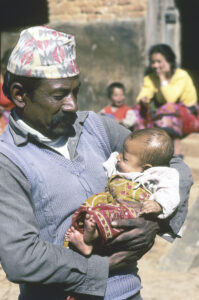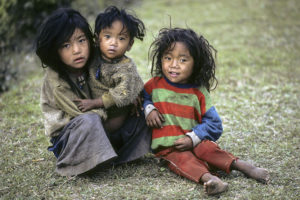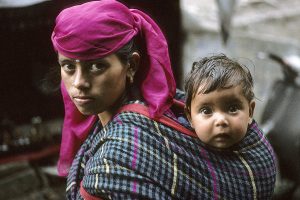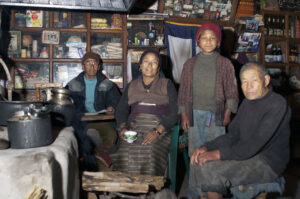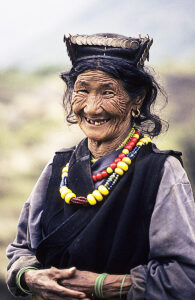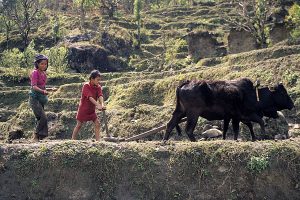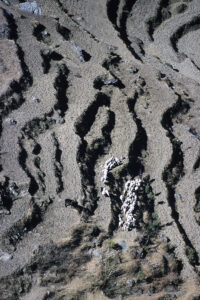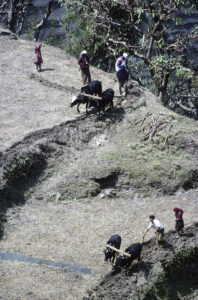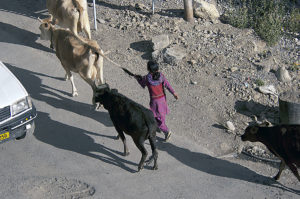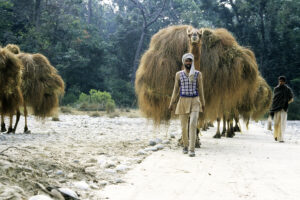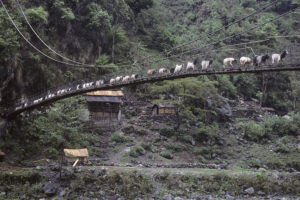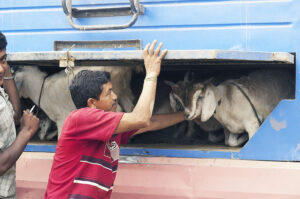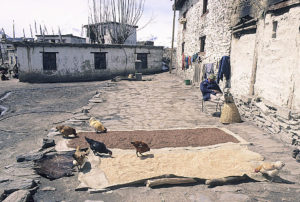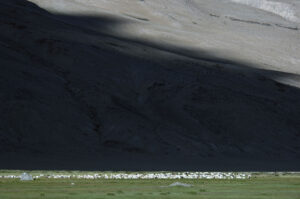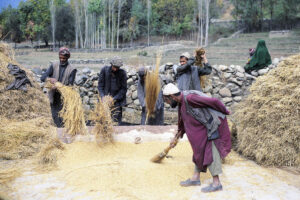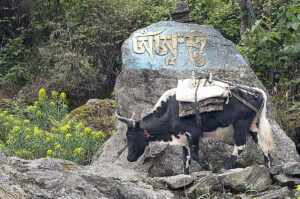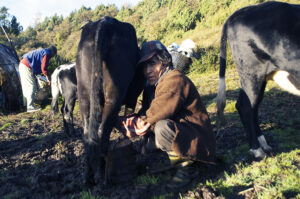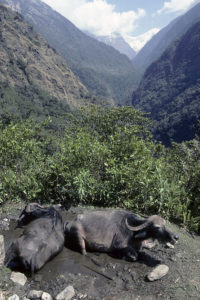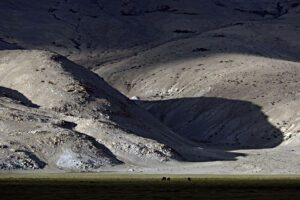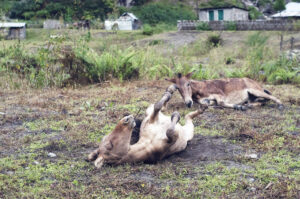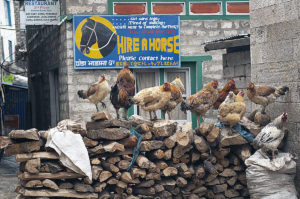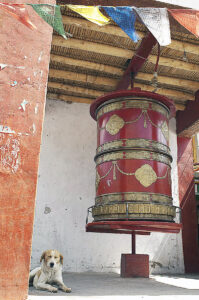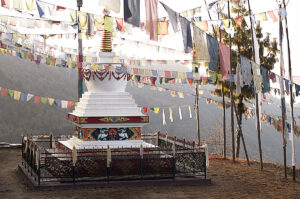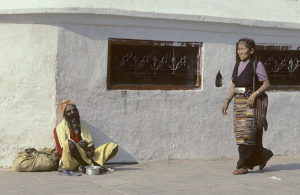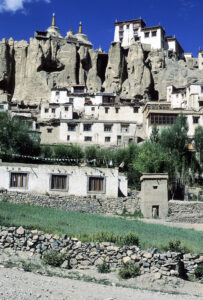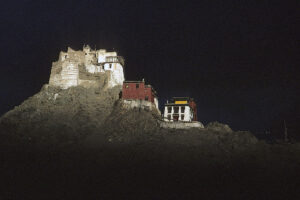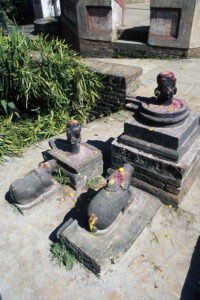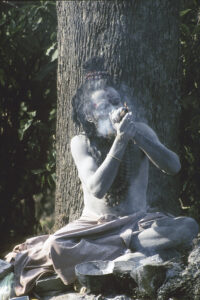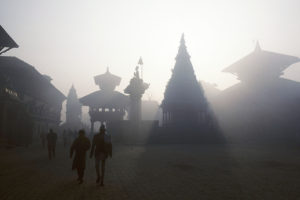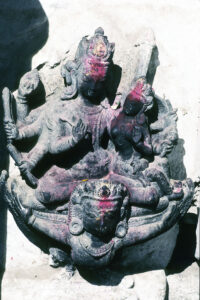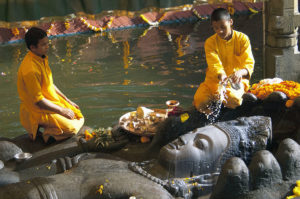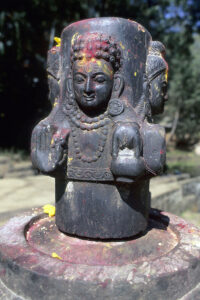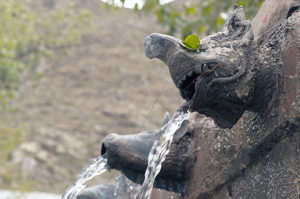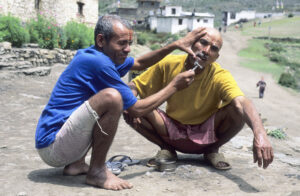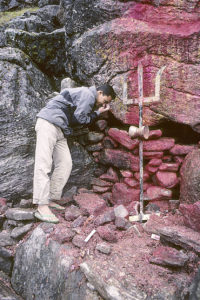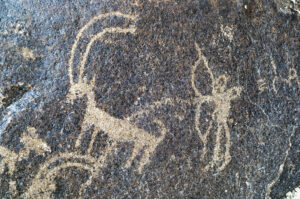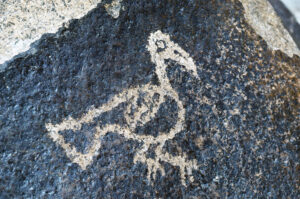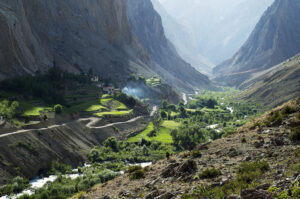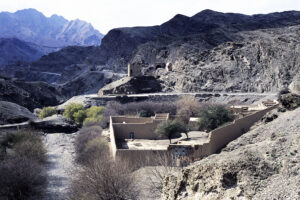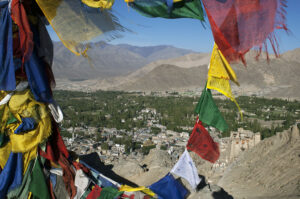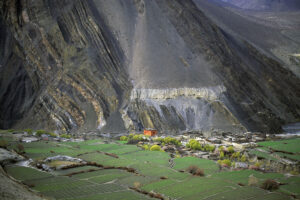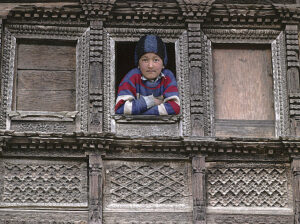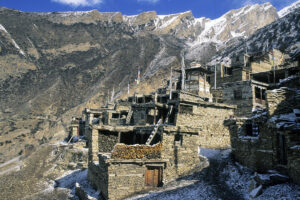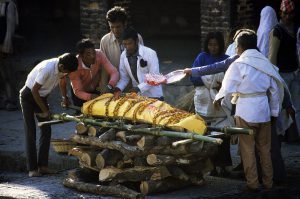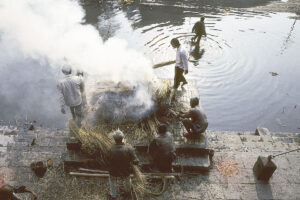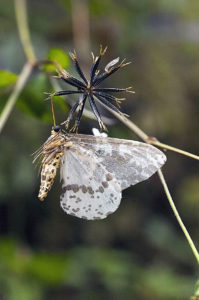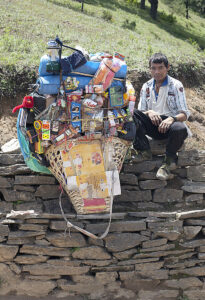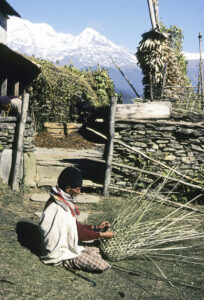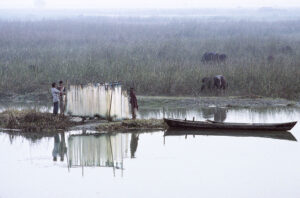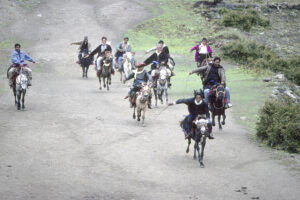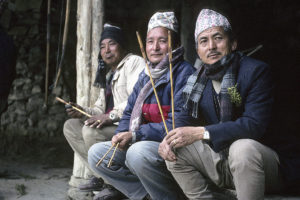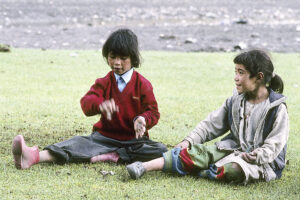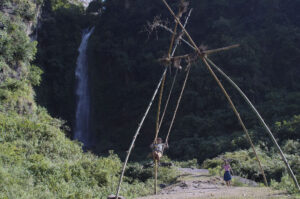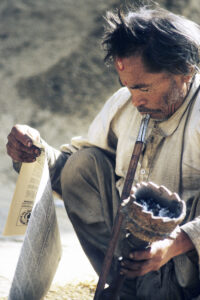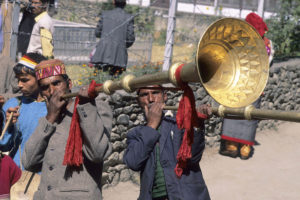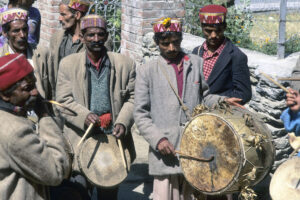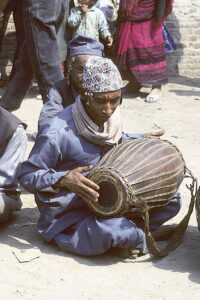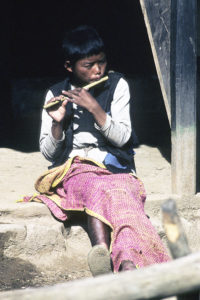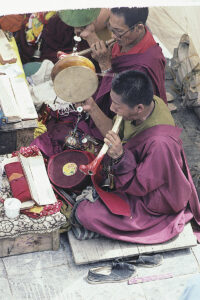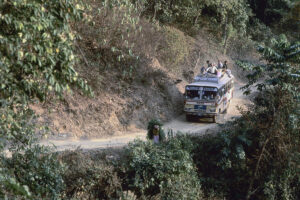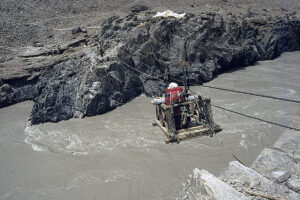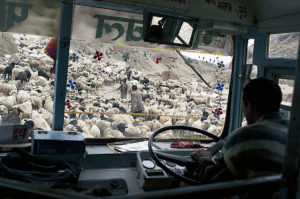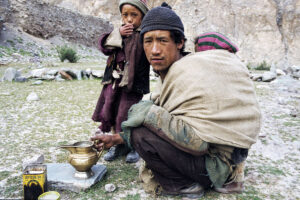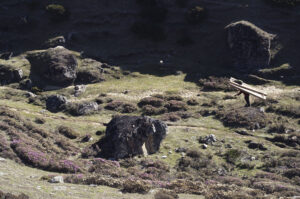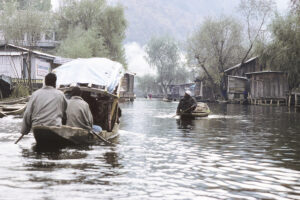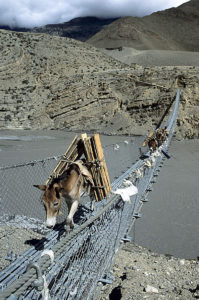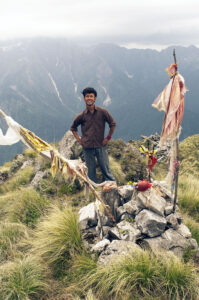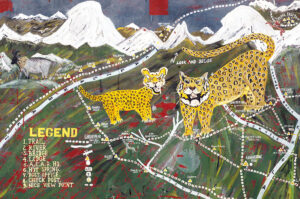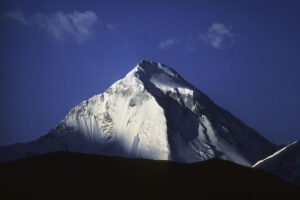Hardy Highlanders – People and Wildlife of the Himalaya
Hardy Highlanders – People and Wildlife of the Himalaya
Copyright © text & photographs by Kaj Halberg, 2014, 2025. All rights reserved.
This flower of the primrose species Primula sessilis is covered in a layer of ice after snow falling the previous day, followed by thawing, and then a freezing night. – Dodi Tal, Uttarakhand, April 1, 2008. (Photo copyright © by Kaj Halberg)
Tibetan prayer flags with printed mantras are ubiquitous in the Himalaya. When these flags flutter in the wind, the mantras are dispersed into space, for the benefit of humankind. – Machhermo, Gokyo Valley, Khumbu, eastern Nepal, June 10, 2010. (Photo copyright © by Kaj Halberg)
In areas dominated by Tibetan Buddhism, or Lamaism, many boys spend longer or shorter periods of time as apprentices in local monasteries, called gompas. – Lamayuru, Ladakh, July 5, 2000. (Photo copyright © by Kaj Halberg)
This book, which has 176 pages, contains 339 photographs from the Himalaya, taken in the period 1978-2013.
For help in different ways, I would like to thank Madhu & Ajai Saxena, Nita & Navaraj Sharma, Uffe Gjøl Sørensen, and Geoff Groom, besides all the guides, porters, cooks, horsemen, and others, without whose help many of my travels in the Himalaya could not have been made. Many heartfelt thanks to Judy Chiang for her suggestions throughout the making of this book.
No part of this book may be reproduced or transmitted in any form or by any means, electronic or mechanical, including photocopying, recording, or by any information storage and retrieval system, without permission in writing from me.
In case you would like to purchase the book, the price is 15 US Dollars plus postage, which must be paid in advance before shipping. You can contact me at the following address: respectnature108@gmail.com.
The edition of the book on this website includes a number of corrections, mainly updating Latin names of a some species. Major corrections have been made to the following picture texts: Primula strumosa, not P. sikkimensis (p. 39), Nanda Devi National Park (p. 56), Grandala coelicolor (p. 61), Heterophasia capistrata (p. 63), Rhabdophis himalayanus, not Xenochrophis piscator (p. 76), Colias fieldii, not C. erate (p. 81), monastery, Tukuche, not Marpha, Impatiens (p. 105), nomads, Changpa, not Rukti (p. 112), Rheum tibeticum, not R. moorcroftianum (p. 113), and sculpture (p. 147).
The animals and plants in the pictures below are descibed in depth on the following pages on this website: Plants: Himalyan flora 1, 2, and 3; Animals – Birds: Birds in the Himalaya; Animals – Mammals: Mammals in the Indian Subcontinent; Animals – Reptiles and amphibians: Reptiles and amphibians in the Indian Subcontinent; and Animals – Invertebrates: Invertebrates in the Himalaya.
About the front cover:
Viburnum is a genus of small trees with pretty, white or pink flowers. As its Latin name implies, Viburnum grandiflorum has the largest flowers among the 8 Himalayan species, and it is the only one to bloom in winter and early spring. The hardy flowers on this Viburnum grandiflorum are covered in a layer of ice and snow, Dodi Tal, Uttarakhand, April 1, 2008. (Photo copyright © by Kaj Halberg)
This book is dedicated to the memory of my good friend
John Andrew Burke
(1951-2010)
who shared many adventures with me in the Himalaya.
John’s favourite quote was the following from Walt Whitmans book Leaves of Grass (1855):
“And to die is different from what any one supposed, and luckier.”
In 1978, John and I made our first Himalayan trek together, to the Khumbu region of eastern Nepal. John especially loved Ama Dablam (6,856 m), a mountain, which is sacred to the local Buddhist Sherpas.
Female porters, outlined against the snow-covered Ama Dablam. (Photo John Burke, copyright © by Kaj Halberg)
Rays from the rising sun spread star-like into the sky behind its double-peak. (Photo copyright © by Kaj Halberg)
During the summer, many families move to temporary shelters in high altitude grazing grounds for yaks, called kharka. Here they milk their female yaks, called nak, daily, making butter and cheese from the milk.
The yak is described on the page Animals – Animals as servants of Man: Cattle, banteng and yak.
This picture shows a Tamang woman and her son, sitting near the kitchen fire in a stone dwelling at Dukpu, below Ganja La, Langtang National Park, central Nepal, September 17, 2009. (Photo copyright © by Kaj Halberg)
Changabang (6864 m) is a striking white granite mountain, situated in Nanda Devi National Park, Uttarakhand. This national park is a wilderness area, parts of which are closed to the public. In the foreground, old-man’s-beard lichens (Usnea) are draped around branches of a Himalayan birch (Betula utilis). – October 12, 1982. (Photo copyright © by Kaj Halberg)
Early in the morning, an almost full Moon sets behind the sacred peak of Machhapuchhare (6993 m), Annapurna Sanctuary, central Nepal, May 28, 2007. (Photo copyright © by Kaj Halberg)
(This picture covers two whole pages in the book.)
The local religion in Tibet, prior to the introduction of Buddhism, was an animistic belief, Bon, whose followers believe that all things in nature – animals, rocks, trees, etc. – contain a spirit, good or evil, and that these spirits control the actions of humans. Today, there are still traces of Bon in the Tibetan Buddhism, including offerings of horns.
Here, a skull of a bharal, or Himalayan blue sheep (Pseudois nayaur), has been placed among prayer flags and juniper branches (Juniperus), Kagbeni, Mustang, central Nepal, May 18, 2007. (Photo copyright © by Kaj Halberg)
Cyananthus is a genus of the bellflower family (Campanulaceae), comprising 9 species in the Himalaya. This is Cyananthus lobatus, told from other species of the genus by its large flowers and lobed leaves. – Cholang Pati, Langtang National Park, central Nepal, September 6, 2009. (Photo copyright © by Kaj Halberg)
Zingiber chrysanthum, of the ginger family, has bright red fruits at ground level. Its seeds are pure white with an irregular black patch, looking somewhat like a fly. – Chamje, Marsyangdi Valley, Annapurna, central Nepal, October 4, 2009. (Photo copyright © by Kaj Halberg)
These Hindu pilgrims, who have just paid a visit to the Vishnu temple of Muktinath, Mustang, central Nepal, are now on their way home, walking down the Kali Gandaki Valley. Here they are crossing a nasty landslide, caused by heavy rain, which has washed away the trail. – August 17, 2000. (Photo copyright © by Kaj Halberg)
On a spring day, dark clouds gather above the Modi Khola Valley, Annapurna, central Nepal, March 25, 1994. Even prior to the monsoon period, this area receives quite heavy rainfall. (Photo copyright © by Kaj Halberg)
Sunlight penetrates these pretty flowers of Chesneya purpurea (also known as Spongiocarpella purpurea), a member of the pea family (Fabaceae), which is very common at high altitudes between 4,000 and 5,200 m. – Gokyo Valley, Khumbu, eastern Nepal, June 11, 2010. (Photo copyright © by Kaj Halberg)
In Buddhist areas of the Himalaya, Tibetan mantras are chiseled into numerous rocks. It is believed that this act will benefit the carver in his next life. Such decorated rocks are called mani stones. – Namche, Khumbu, eastern Nepal, May 29, 2010. (Photo copyright © by Kaj Halberg)
This Ladakhi shaman is wearing the typical high felt hat of the area, and a rosary with 108 beads, made from plant seeds. Officially, Ladakhi shamans are Buddhists, but their practice contains many traces from the pre-Buddhist religion of Central Asia, Bon, which was mainly animistic. – Rumbakh, Markha Valley, Ladakh, August 26, 1982. (Photo copyright © by Kaj Halberg)
These boys have a great time, playing with a wheelbarrow in a sea of silver-headed grass, Tumlingtar, Arun Valley, eastern Nepal, April 19, 1991. (Photo copyright © by Kaj Halberg)
An avalanche roars down the Bethartholi Glacier, Nanda Devi National Park, Uttarakhand, October 14, 1982. A significant part of the High Himalaya is covered in eternal ice and snow, but glaciers have been receding steadily during the last five decades. (Photo copyright © by Kaj Halberg)
Outside their mother’s restaurant in Kopche Pani, Kali Gandaki, Annapurna, central Nepal, these little girls greet me the Nepalese way, cupping their hands and saying Namaste (see further about Himalayan greetings at Betrawati below). Today’s menu is written on the blackboard, but it seems that it has not been changed for quite some time. – May 22, 2007. (Photo copyright © by Kaj Halberg)
Children in the Himalaya are accustomed to work from an early age. These boys carry firewood to their home in Chame, Marsyangdi Valley, Annapurna, central Nepal, October 31, 1985. (Photo copyright © by Kaj Halberg)
Assisted by her guide, Madhu Saxena crosses a temporary bridge in Tirthan Valley, Great Himalayan National Park, Himachal Pradesh, June 13, 2007. Every year, heavy monsoon showers destroy many trails in the Himalaya. In this case, the main trail had been eroded away, and a new ‘path’ had been constructed, much of it leading through the Tirthan River itself. (Photo copyright © by Kaj Halberg)
The Gokyo Lakes are a chain of 6 alpine lakes in the Khumbu area of eastern Nepal, creating a rare and unique ecosystem. These lakes are included in the so-called Ramsar sites, a worldwide net of wetlands, which are supposed to be preserved for future generations. However, the meadows around the Gokyo Lakes are far too heavily grazed by numerous herds of yaks.
The largest of the Gokyo Lakes, June 11, 2010. (Photo copyright © by Kaj Halberg)
A heavily loaded porter passes through smoke from morning cooking, seeping out of a house in Koto, Marsyangdi Valley, Annapurna, central Nepal, October 12, 2009. (Photo copyright © by Kaj Halberg)
A Kashmiri shopkeeper in Srinagar enjoys smoking his water pipe. He is wearing the typical dress of Kashmiri Muslims: Baggy trousers, black European style jacket, and a small cap. – October 31, 1997. (Photo copyright © by Kaj Halberg)
Indian forester B.P. Bahuguna shows a leaf of spiny-leaved oak (Quercus semecarpifolia), which has been partly eaten by a white-bellied giant flying squirrel (Petaurista albiventer), described on the page Animals – Mammals: Squirrels. The squirrel always eats only part of the leaf, by folding it up and biting the central, less toxic part. – Maji, Uttarakhand, March 30, 2008. (Photo copyright © by Kaj Halberg)
At dusk, ruins of an old fort are outlined against a blue sky, soon to be covered in heavy rainclouds, Markha, Ladakh, July 13, 2000. (Photo copyright © by Kaj Halberg)
On a chilly winter morning, seed-heads of a tall grass stem are heavy with dew, Corbett National Park, Uttarakhand, December 28, 1985. (Photo copyright © by Kaj Halberg)
Ghost mountain. – The shadow of a jagged mountain ridge is reflected on clouds above Surkhe, Solu, eastern Nepal, June 16, 2010. (Photo copyright © by Kaj Halberg)
This elderly Gurung man is taking care of his grandchildren, Galeshwor, Kali Gandaki, Annapurna, central Nepal, May 15, 2007. (Photo copyright © by Kaj Halberg)
Sunrise, viewed from Banthanti, Annapurna, central Nepal, May 24, 2007. To the left, the characteristic double-peak of Machhapuchhare (‘Fish-tail Peak’) (6993 m) is seen. This mountain is sacred to the local people, and its peak may not be scaled. (Photo copyright © by Kaj Halberg)
Due to their showy flowers, peonies are popular garden plants. In the Himalaya, a single species is found, the Himalayan peony (Paeonia emodi), which grows at medium altitudes, from Pakistan to western Nepal. – Sangam Chatti, Uttarakhand, March 29, 2008. (Photo copyright © by Kaj Halberg)
Species of Androsace, or rock-jasmine, many of them mat-forming, are ubiquitous in the Himalaya, mostly at high altitudes. They are closely related to primroses (Primula), but can be told from that genus by their very short corolla-tube (a tube, formed by the petals).
Androsace muscoidea, Dhela, Great Himalayan National Park, Himachal Pradesh, June 25, 2007. (Photo copyright © by Kaj Halberg)
With Dhaulagiri (8167 m) as a spectacular background, mother and son enjoy a well-deserved rest before carrying rolls of mats to a nearby market in Naya Phul, Annapurna, central Nepal, November 24, 1985. (Photo copyright © by Kaj Halberg)
The common greeting in most parts of the Himalaya is Namaste, which literally means something like: ‘I salute the god within you.’ While saying Namaste, you cup your hands in front of your face or chest. In areas with predominantly Tibetan inhabitants, the common greeting is Tashi deleg, which means: ‘Good and auspicious’ (blessings upon you). In Ladakh, this greeting is shortened to Shylay. In Pakistan, where almost all inhabitants are Muslims, you mostly hear the Arabic greeting Salaam aleikum (‘Peace upon you’), and in return you say Aleikum as salaam.
These little girls greet me while saying Namaste, Betrawati, Trisuli River, central Nepal, September 27, 2009. (Photo copyright © by Kaj Halberg)
Pleione orchids mostly grow on moss-covered tree trunks, including toppled ones. This picture shows Pleione hookeriana, which is very common on oaks and conifers at elevations between 2,000 and 3,700 m. – Langtang Valley, central Nepal, May 31, 1987. (Photo copyright © by Kaj Halberg)
Sitting on a large rock, this man is trying his luck angling in the Lower Marsyangdi River, north of Besisahar, central Nepal, March 6, 1998. (Photo copyright © by Kaj Halberg)
Gentians are very common at high altitudes in the Himalaya, and no less than about 60 species are found. The flowers of most species are different shades of blue. Almost all gentians bloom late in the summer or in autumn, but a few are spring-flowering, including the tiny Gentiana pedicellata, which is very common on grazing grounds at medium altitudes.
This picture shows Gentiana ornata, encountered at Ngegang Kharka, Langtang National Park, central Nepal, September 15, 2009. (Photo copyright © by Kaj Halberg)
On their way to the Vishnu temple Muktinath, Mustang, central Nepal, these Hindu pilgrims are crossing a tributary to the Kali Gandaki River, August 12, 2000. (Photo copyright © by Kaj Halberg)
Clouds, illuminated by the morning sun, behind the jagged peak of Lhotse (8511 m), Khumbu, eastern Nepal, June 3, 2010. (Photo copyright © by Kaj Halberg)
Early morning fog gives way to sunshine in an oak forest near Ghare, Annapurna, central Nepal, May 22, 2007. (Photo copyright © by Kaj Halberg)
Morning sunshine glows on the snow-clad top of Annapurna II (7939 m), viewed from Dukur Pokhari, Marsyangdi Valley, Annapurna, central Nepal, October 9, 2009. (Photo copyright © by Kaj Halberg)
Late afternoon sunlight casts long shadows on barren rocks near Honupatta, Shila River Valley, Ladakh, August 8, 2009. (Photo copyright © by Kaj Halberg)
‘Abode of Snow’
A hundred divine epochs would not suffice to describe all the marvels of the Himalaya.
Sanskrit proverb.
The word Himalaya is composed of the Sanskrit words hima (‘snow’) and alaya (‘abode’), thus meaning ‘The Abode of Snow’. The Himalaya consists of a long arch of gigantic mountains, stretching from northern Pakistan southeast to the northern tip of Myanmar – a distance of more than 2,500 km. Here you find the Earth’s largest concentration of very high mountain tops – 14 peaks reach an altitude of more than 8,000 m, and hundreds are more than 7,000 m high. (For comparison, the highest mountain outside Central Asia – Aconcagua in Argentina – is a mere 6,962 m high.)
The four highest mountain tops in the Himalaya are Sagarmatha, or Mount Everest (8850 m) (called Chomolangma in Tibet) on the border between Nepal and Tibet; K 2, or Godwin Austen (8611 m) (locally called Dapsang) on the border between Pakistan and Xinjiang; Kangchendzonga, or Kanchenjunga (8586 m) on the border between Nepal and Sikkim; and Lhotse (8511 m), close to Sagarmatha.
The borders of the Himalaya are not well defined. To the northwest, the Karakoram Mountains (which some authorities consider a part of the Himalaya, others do not) merge into the Hindu Kush and Pamir Mountains, and to the north and northeast, several mountain chains in Ladakh, Tibet, and China are a continuation of the Himalaya proper.
As you move from east to west in the Himalaya, annual rainfall diminishes greatly, and the north-western part of the mountains – northern Pakistan, Ladakh, northern Himachal Pradesh, and north-western Nepal – are barren and desert-like, while the easternmost parts are incredibly lush.
As a result of the great span in altitude and precipitation – besides various other factors such as micro-climate and soil composition – flora and fauna of the Himalaya are indeed diverse. In these mountains, two bio-geographical zones meet: The Oriental Zone, containing species from the Indian Subcontinent and Southeast Asia, and the Palaearctic Zone, containing species of Central or West Asian origin. Approximately 10,000 species of seed-bearing plants grow here, besides many hundred species of fungi, lichens, mosses, clubmosses, ferns, and other spore-bearing plants. No less than c. 900 species of birds have been observed in the Himalaya, besides c. 200 species of mammals, c. 150 species of reptiles, c. 50 species of amphibians, c. 800 species of butterflies, and innumerable other invertebrates.
Numerous peoples of diverse origin inhabit the Himalaya. People in the north-western part of the mountains, in Pakistan, Kashmir, southern Himachal Pradesh, and Uttarakhand, are mainly of Caucasian origin, known by the term Indo-Aryans. Their forefathers migrated here some 3,500 years ago from the steppes around the Caspian Sea. In Zanskar, Ladakh, Lahaul, Spiti, most of Nepal, Sikkim, and Bhutan, a multitude of various Mongoloid peoples are found, many of which emigrated from Central Asia hundreds, or even thousands, of years ago. The ancestry of the Newar people of central Nepal is not clear, but their blood is probably mixed Indo-Aryan and Mongoloid. The many tribal peoples in Arunachal Pradesh and northern Myanmar are Mongoloids, probably originating from Thailand or southern China.

A thin layer of clouds seems to wrap itself around the double-peak of Machhapuchhare (‘Fish-tail Peak’) (6993 m), Modi Khola Valley, Annapurna, central Nepal, May 30, 2007. The tree is a Nepalese alder (Alnus nepalensis). (Photo copyright © by Kaj Halberg)
Male musk deer have been hunted heavily for their musk gland, with which they mark their territory. The musk is used in traditional folk medicine, and for perfume. In many areas of the Himalaya, these animals have become extinct, but in the Khumbu area of eastern Nepal the Sherpa people protect them, as their religion bans killing.
A male Himalayan musk deer (Moschus chrysogaster) enjoys his meal of old-man’s-beard lichens (Usnea), which have fallen to the forest floor, Pungi Tenga, Khumbu, eastern Nepal, May 30, 2010. (Photo copyright © by Kaj Halberg)
The large and elusive snow leopard (Panthera uncia) lives in mountains of Central Asia, but has been hunted to extinction in many areas because of their rich and beautiful fur. In Buddhist areas like Ladakh, Sikkim, and Bhutan, and Khumbu and Dolpo in Nepal, hunting is banned, and these rare cats here have safe heavens, where they can prey on species like bharal (Pseudois nayaur), urial (Ovis vignei), Himalayan tahr (Hemitragus jemlahicus), and Himalayan musk deer (Moschus chrysogaster).
Partly melted pugmarks in the snow signify that a snow leopard has passed here the previous night, Jarsang Khola Valley, Annapurna, central Nepal, March 14, 1998. (Photo copyright © by Kaj Halberg)
The Kali Gandaki River drains the entire landscape of Mustang, central Nepal. As rainfall in Mustang is rather limited, the riverbed of the Kali Gandaki is almost dry for the major part of the year. The trees along the river are willows (Salix). To the left is Nilgiri (7061 m), one of numerous peaks in the Annapurna Massif. – November 11, 1985. (Photo copyright © by Kaj Halberg)
The Moon sitting high above, late afternoon sunshine illuminates the top of Thamserku (6,608 m), and a thick blanket of clouds covers the Dudh Kosi Valley, Khumbu, eastern Nepal, May 23, 2002. (Photo copyright © by Kaj Halberg)
Mountain Abloom
Flowers of Hackelia uncinatum, covered in morning dew, Dhela, Great Himalayan National Park, Himachal Pradesh, June 24, 2007. Like most members of the forget-me-not family (Boraginaceae), this species is quite bristly-hairy. (Photo copyright © by Kaj Halberg)
Balanophora dioica is a seed-plant, but looks rather like a fungus. It contains no chlorophyll, being a parasite that obtains all necessary nutrients from tree roots. – Bamboo, Langtang Valley, central Nepal, September 9, 2009. (Photo copyright © by Kaj Halberg)
The gorgeous Nepalese lily (Lilium nepalense) is fairly common, growing on steep slopes at medium altitudes from Uttarakhand eastwards. It blooms in June-July. – Ringmo, Solu, eastern Nepal, June 19, 2010. (Photo copyright © by Kaj Halberg)
There are about 20 species of roseroots (Rhodiola) in the Himalaya. In the past, they were lumped with stonecrops in the genus Sedum, but they differ from stonecrops by having a stout rhizome (rootstock) and only 4 petals, versus a slender or no rootstock and 5 petals in Sedum species.
This photograph shows an unidentified Rhodiola species, observed at Langshisa, Langtang National Park, central Nepal, June 3, 2002. (Photo copyright © by Kaj Halberg)
The leaves of several Himalayan plant species are hugging the ground, an adaptation to protect the plant against evaporation and fierce winds. A disadvantage is that in sandy soils gusts of wind will blow sand onto the leaves, thus diminishing their ability to obtain energy from sunlight through photosynthesis.
Two examples of ground-hugging plants are Phlomoides rotata (previously called Lamiophlomis rotata) (top) and Scrophularia wattii (previously known as Oreosolen wattii), both photographed near Chhukung, Khumbu, eastern Nepal, June 4, 2010. (Photo copyright © by Kaj Halberg)
Thermopsis barbata is a very hairy member of the pea family, easily recognized by its chocolate-brown flowers. Its scientific name is derived from Ancient Greek therme (‘heat’) and opsis (‘appearance’), and from the Latin barbatus (‘bearded’), thus ‘the bearded one that appears to be burned’. This species is very common on disturbed ground at altitudes between 3,000 and 4,500 m, including abandoned fields and heavily grazed slopes.
Thermopsis barbata, Namche, Khumbu, eastern Nepal, May 29, 2010. (Photo copyright © by Kaj Halberg)
In the genus Saussurea, of the huge composite family (Asteraceae), many species are adapted to the cold and dry conditions at high altitudes. This is Saussurea elliptica, told from other small species in the genus by its elliptic leaves. – Honupatta, Ladakh, August 7, 2009. (Photo copyright © by Kaj Halberg)
Several other Saussurea species look almost like cotton balls. A dense hair cover insolates the plant and protects it against cold and drought. These Saussurea gossypiphora were found at an altitude of about 5,000 m near Ganja La, Langtang National Park, central Nepal, September 15, 2009. (Photo copyright © by Kaj Halberg)
About 18 Begonia species are found in the Himalaya, growing mainly on shady banks, or on large tree trunks. This picture shows Begonia rubella, which is fairly common in Helambu, central Nepal. – August 31, 2009. (Photo copyright © by Kaj Halberg)
Eriophyton wallichii is an extremely hairy plant of high altitudes. It belongs to the mint family, Lamiaceae, or Labiatae. – Laurebina La, Langtang National Park, central Nepal, September 5, 2009. (Photo copyright © by Kaj Halberg)
Osbeckia is a genus of bushes with pretty flowers, belonging to the family Melastomataceae. This is Osbeckia stellata, by far the most common species in the Himalaya. An iridiscent beetle is sitting on one of the petals. – Pati Bhanjyang, Helambu, central Nepal, September 1, 2009. (Photo copyright © by Kaj Halberg)
About 24 species of Strobilanthes, of the acanthus family (Acanthaceae), are found in the Himalaya. Here is Strobilanthes attenuata (formerly named Pteracanthus urticifolius), covered in raindrops from a recent shower, Shyabru, Langtang National Park, central Nepal, September 1, 2000. (Photo copyright © by Kaj Halberg)
‘Cow Dung’
The plant genus Primula, known as primroses or cowslips, occurs in most parts of the world, but probably originated in the Himalaya. A bewildering array of similar species is found here – about 70 in total, ranging from 5 cm high dwarfs to robust plants almost 1 m tall. The name cowslip is derived from the Old English word cuslyppe, meaning ‘cow dung’. This probably refers to the fact that many primrose species grow on cattle grazing grounds, which is also the case in the Himalaya.
Snow, falling the previous night, has partly buried these Primula irregularis flowers, Tharepati, Helambu, central Nepal, March 4, 2008. (Photo copyright © by Kaj Halberg)
Primula denticulata is very common and has a broad altitudinal range, found at altitudes between 1,500 and 4,500 m. – Lukla, Khumbu, eastern Nepal, April 3, 1987. (Photo copyright © by Kaj Halberg)
The pretty Primula strumosa has yellow flowers, usually with a golden-yellow eye, gathered in an umbel at the end of a stalk, which may grow to 20 cm tall. It occurs in forests and meadows at altitudes between 3,500 and 4,300 m, from western Nepal eastwards to Bhutan and south-eastern Tibet. The plants with bluish flowers are Primula denticulata. – Annapurna Sanctuary, central Nepal, May 28, 2007. (Photo copyright © by Kaj Halberg)
With its broadly bell-shaped flowers, Primula wollastonii differs significantly from most other species in the genus. – Gokyo Valley, Khumbu, eastern Nepal, June 12, 2010. (Photo copyright © by Kaj Halberg)
The stout Primula macrophylla grows mainly along mountain streams. The white powder on the underside of the leaves is called farina (the Latin word for flour). – Chhukung, Khumbu, eastern Nepal, June 4, 2010. (Photo copyright © by Kaj Halberg)
Cinquefoil Colours
The word cinquefoil is an Anglicization of the Latin quinque (‘five’) and folium (‘leaf’), thus ‘five-leaf’, a name originally referring to those species of the genus Potentilla, which have 5 finger-like leaflets. Today, however, cinquefoil is a name that refers to the entire genus, and also to marsh cinquefoils of the genus Comarum, and to Farinopsis salesoviana (below). These mostly small and ground-hugging plants belong to the rose family (Rosaceae). There are no less than about 40 species in the Himalaya, many of them widespread and common. The vast majority are yellow-flowered, but a few have orange, pink, red, or white flowers.
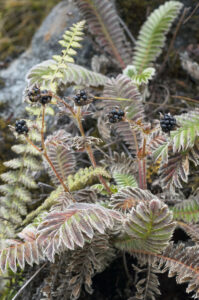
Cinquefoil fruits are called achenes. They are small, hard, and nut-like, densely clustered in a fruit-head. The achenes of Potentilla peduncularis are dark brown or blackish, forming what looks like a bramble berry. This species is common on high altitude grazing grounds, here observed at Dukpu, Langtang National Park, central Nepal, September 17, 2009. (Photo copyright © by Kaj Halberg)
The rather shrubby Farinopsis salesoviana, one of the few white-flowered cinquefoils, is widespread in Central Asia. It was previously called Comarum salesovianum, believed to be closely related to the circumboreal marsh cinquefoil (Comarum palustre), but contrary to that species, it grows in dry conditions. – Honupatta, Ladakh, August 8, 2009. (Photo copyright © by Kaj Halberg)
Potentilla microphylla is quite common in open areas at high altitudes. It is easily identified by its small, densely pinnate, hairy leaves, hugging the ground. The violet flowers are Tibetia himalaica (previously called Gueldenstaedtia himalaica), which belongs to the pea family (Fabaceae). – Dole, Gokyo Valley, Khumbu, eastern Nepal, June 8, 2010. (Photo copyright © by Kaj Halberg)
The flower colour of Potentilla argyrophylla varies greatly, from yellow or orange to crimson (var. atrosanguinea, shown here) or purplish-red. It can be told from other cinquefoil species by its strawberry-like leaves, which are either densely silky-hairy or dark green with paler undersides. – Annapurna Sanctuary, central Nepal, May 27, 2007. (Photo copyright © by Kaj Halberg)
Strange Arums
Flowers of the genus Arisaema, of the arum family (Araceae), are very distinctive, having a large, often brightly coloured blade, called a spathe. This blade encircles the central club-shaped spadix, on which numerous tiny flowers are clustered, male flowers above, females below. Spathe and spadix often have a thread-like tip, which in some species is quite grotesque, growing up to 1 m long. The flowers are often foul-smelling, attracting flies that pollinate them. The fruit is a cluster of bright red berries, remaining on the spadix after the spathe has withered.
A common name of these plants is Jack-in-the-pulpit. To some people, the flower looked like a person in a pulpit: ‘Jack’ is the flowering club, and the ‘pulpit’ is the spathe. Another name is cobra plant, referring to the cobra-like spathe of some species. The Nepalese name for these plants, sarpa ko makai (‘snake-maize’), also refers to the cobra-like spathe, and to the cluster of berries, which resembles a maize cob.
The thread-like tip of the spadix of Arisaema costatum is quite grotesque, growing to a length of up to 1 m. – Surkhe, Solu, eastern Nepal, June 16, 2010. (Photo copyright © by Kaj Halberg)
Arisaema nepenthoides is often called cobra plant, referring to its spathe, which looks like the spread-out hood of a cobra. – Tadapani, Annapurna, central Nepal, April 4, 1991. (Photo copyright © by Kaj Halberg)
The purplish, velvety spadix of Arisaema tortuosum points 7-12 cm upwards, looking rather like an old man, pointing with his walking stick. – Lukla, Khumbu, eastern Nepal, May 26, 2010. (Photo copyright © by Kaj Halberg)
The fruit of Arisaema species is a cluster of berries, resembling a maize cob. This unidentified species was observed at Lata, Uttarakhand, October 8, 1982. A velvety butterfly is sitting on the fruit. (Photo copyright © by Kaj Halberg)
Arisaema erubescens is easily recognized by its 7 to 14 radiating, narrow leaflets, and the brown- and white-striped spathe. – Choplong, Khumbu, eastern Nepal, May 25, 2010. (Photo copyright © by Kaj Halberg)
Gundruk
Outside the summer months, fresh vegetables are often difficult to find in rural areas of the Himalaya. A widespread method of obtaining nutrients from vegetables at times, when fresh ones are not available, is to make gundruk – fermented leaves of certain cultivated plants, for instance cabbage, mustard, and radish, and of different wild plants, including Arisaema utile, the buttercup Ranunculus diffusus, and Nepalese dock (Rumex nepalensis).
Two methods are utilized to make gundruk. One is to wash the leaves and leave them to dry for a day, after which the last juice is beaten out of them. They are then stuffed firmly into a container, which is tightly closed, making it airtight. About a week later, the fermented leaves are taken out and left to dry in the sun, after which they are stored in a dry place for later use. Another method is to boil the leaves for a short time and then stuff them tightly in a container. After a short period of time, the juice is removed and boiling water added. The leaves are then left to ferment for 4-5 days, before being dried in the sun.
In the Annapurna area, central Nepal, the leaves of Arisaema utile are much utilized for making gundruk. In this picture, fermented leaves have been spread out to dry in the sun, together with young fern shoots (in front, left), later to be cooked as a vegetable. – May 24, 2007. (Photo copyright © by Kaj Halberg)
‘Rose Trees’
In Ancient Greek, rhododendron means ‘rose tree’. These trees and shrubs are not at all related to roses, but belong to the heath family (Ericaceae). From a distance, however, the flower clusters of some rhododendron species look a bit like roses.
Rhododendron is a very large genus with about 1,025 species worldwide, the largest concentrations encountered in China, the Himalaya, Malaysia, Borneo, and New Guinea. There are about 80 species in the Himalaya, most of them growing from Sikkim eastwards. They vary greatly in size, from 15 metre high trees, such as R. arboreum and R. grande, to ground-hugging dwarf shrubs, for instance R. anthopogon and R. pumilum.
As you move west along the mountain chain, you find fewer and fewer species, and in northern Pakistan there are only 4: R. arboreum, R. campanulatum, R. anthopogon, and R. lepidotum.
Rhododendron campylocarpum is very common in eastern Nepal. Here it grows beneath fluttering Tibetan prayer flags at Tengboche Monastery, Khumbu, May 31, 2010. The mountains in the background are (from left) Nuptse (7879 m), Sagarmatha (8850 m), whose peak is just protruding, and Lhotse (8511 m). (Photo copyright © by Kaj Halberg)
The bell-shaped flowers of Rhododendron wightii are white or very pale yellow with crimson spots within, and its leaves are large, to 20 centimetres long, with felt-like, rusty hairs beneath. It is a shrub, growing to 4 m tall. – Barun Valley, eastern Nepal, May 8, 1991. The dark rock in the background is called Neh. (Photo copyright © by Kaj Halberg)
Rhododendron thomsonii is a shrub, found from eastern Nepal eastwards to south-eastern Tibet. It prefers humid soils, growing mainly along water courses. It can be identified by its broadly bell-shaped, waxy, fleshy flowers, and the rather small, pink calyx. – Ghunsa Valley, eastern Nepal, May 13, 2013. (Photo copyright © by Kaj Halberg)
Rhododendron dalhousiae is an epiphytic plant, i.e. it grows on trees without harming them. Initially, it has large lemon-yellow flowers, which later turn white, with a lemon-like fragrance. It was described in 1848 by the eminent British botanist Joseph Dalton Hooker, who named this lovely plant after Lady Dalhousie, wife of the Governor of India. – Tashigaon, Arun Valley, eastern Nepal, April 25, 1991. (Photo copyright © by Kaj Halberg)
Orchids
The majority of Himalayan orchid species are epiphytes, i.e. they grow on trees without harming them. The gorgeous Coelogyne nitida is very common on trees and rocks at altitudes between 1,500 and 2,500 m. – Modi Khola Valley, Annapurna, central Nepal, May 2007. (Photos copyright © by Kaj Halberg)
The Himalayan lady’s slipper (Cypripedium himalaicum) is a ground-living orchid, growing in grassy areas at elevations between 3,000 and 4,300 m. It blooms during the monsoon. – Dhela, Great Himalayan National Park, Himachal Pradesh, June 24, 2007. (Photo copyright © by Kaj Halberg)
The pretty Calanthe tricarinata is one of the most common ground-dwelling orchids in Himalayan oak forests. – Humkhani, Great Himalayan National Park, Himachal Pradesh, June 22, 2007. (Photo copyright © by Kaj Halberg)
Satyrium nepalense is very common in the Himalaya, from Pakistan in the west to Myanmar in the east, growing in grassy areas and forest edges up to altitudes around 4,600 m. In this photograph, several specimens grow in a lush meadow among numerous pearly everlastings (Anaphalis), Magingoth, Langtang National Park, central Nepal, September 2, 2009. (Photo copyright © by Kaj Halberg)
Bristly Beauties
Meconopsis is a genus of gorgeous poppies, counting about 95 species, which are restricted to central and eastern Asia. About 20 species of these bristly beauties are found in the Himalaya, several of them very common. Many species are grown as ornamentals in the West. The genus name is derived from Ancient Greek mekon (‘moon’) and opsis (‘looking like’) – many of the species have round, yellowish petals.
Meconopsis paniculata is the tallest species in the genus, growing to a height of 2 m. It is very common on cattle grazing grounds throughout the higher parts of the Himalaya, from Uttarakhand eastwards. – Beding, Rolwaling Valley, eastern Nepal, August 4, 2004. (Photo copyright © by Kaj Halberg)
Much hybridization takes place in the Meconopsis genus. It is not clear, whether Meconopsis dhwojii is to be considered a hybrid or a full species. – Kyanjin Gompa, Langtang National Park, central Nepal, June 4, 2002. (Photo copyright © by Kaj Halberg)
Several species of Meconopsis with sky-blue flowers are found from Kashmir eastwards to China. This is Meconopsis simplicifolia, easily recognized by its mostly undivided leaves. It grows among rocks in forests as well as in open areas. – Dole, Gokyo Valley, Khumbu, eastern Nepal, June 12, 2010. (Photo copyright © by Kaj Halberg)
Meconopsis aculeata is found in the western part of the Himalaya, from Pakistan eastwards to Uttarakhand, growing in rocky areas at elevations between 3,000 and 4,000 m. – Rakhundi, Great Himalayan National Park, Himachal Pradesh, June 17, 2007. (Photo copyright © by Kaj Halberg)
Edible Berries
In the past, the genus Viburnum was lumped with elderberries (Sambucus) in the family Sambucaceae, but was then moved to the honeysuckle family (Caprifoliaceae). Recent DNA studies have shown that both of these genera belong to the moschatel family (Adoxaceae), whose name has now been changed to Viburnaceae.
In autumn, several Viburnum species have large clusters of scarlet, edible berries. This is Viburnum mullaha, which is quite common at forest edges and in open areas at altitudes between 1,500 and 3,000 m. – Timang, Marsyangdi Valley, Annapurna, central Nepal, October 8, 2009. (Photo copyright © by Kaj Halberg)
In the Himalaya, there are no less than about 45 species of bramble, or raspberry (Rubus). Most of them are large, rambling, prickly shrubs, like this Rubus hoffmeisterianus, which is fairly common in thickets and along trails. Its red or orange berries are edible, with a slightly acid taste. – Pati Bhanjyang, Helambu, central Nepal, September 1, 2009. (Photo copyright © by Kaj Halberg)
Rubus nepalensis is a very common species, creeping along the ground in open forests and near trails. Its berries are very tasty, at the same time sweet and slightly acid. In the lower left corner of the photograph are clubmosses (Lycopodium), and the blue flower is Cyanotis vaga, a member of the dayflower family (Commelinaceae). – Gul Bhanjyang, Helambu, central Nepal, September 2, 2009. (Photo copyright © by Kaj Halberg)
Rubus ellipticus has the most sweet-tasting fruits of all Himalayan bramble species. Here, Dil Bahadur Pantha shows two handfuls of these delicious yellow berries, Hellok, Tamur Valley, eastern Nepal, May 8, 1994. (Photo copyright © by Kaj Halberg)
Common names of Gaultheria species include wintergreen and mountain tea. They are a widespread genus of shrubs or dwarf shrubs, with 7 species occurring in the Himalaya. Gaultheria trichophylla is a very common dwarf shrub, creeping over rocks and forest slopes. In autumn, it is easily recognized by its sky-blue berries, which are edible. – Gopte, Langtang National Park, central Nepal, August 28, 2000. (Photo copyright © by Kaj Halberg)
Lush Forests
The mountains around Ghorepani and Tadapani in the Annapurna Mountains, central Nepal, are a wonderful sight in spring, when large tracts of forest are painted pink by millions of Rhododendron arboreum flowers. – Banthanti, March 13, 2008. (Photos copyright © by Kaj Halberg)
Old-man’s-beard lichens (Usnea) drape the branches of a tail-leaved maple (Acer caudatum), Deboche, Khumbu, eastern Nepal, June 1, 2010. (Photo copyright © by Kaj Halberg)
During the peak of the monsoon, this oak forest in the Rolwaling Valley, eastern Nepal, is incredibly lush, the great trees heavily laden with epiphytes such as mosses, ferns, and Begonia flowers. – August 5, 2004. (Photo copyright © by Kaj Halberg)
The first rays of the morning sun illuminate a forest with many species of broadleaved trees, including Quercus floribunda, Quercus lanata, Rhododendron arboreum, Dodecadenia grandiflora, Lindera pulcherrima, and Viburnum erubescens, mixed with a single conifer, the Himalayan hemlock (Tsuga dumosa). – Banthanti, Annapurna, central Nepal, May 24, 2007. (Photo copyright © by Kaj Halberg)
Fog evaporates in the morning sun in a dense forest of Himalayan silver fir (Abies spectabilis). The trunks are covered in mosses, lichens, and ferns. – Cholang Pati, Langtang National Park, central Nepal, September 7, 2009 . (Photo copyright © by Kaj Halberg)
The reddish bark of the Himalayan birch (Betula utilis) peels off in large, thin flakes. – Deboche, Khumbu, eastern Nepal, May 31, 2010. (Photo copyright © by Kaj Halberg)
Autumn Ablaze
Growing on a slope along the Rishi Ganga gorge, Nanda Devi National Park, Uttarakhand, scattered Himalayan silver firs (Abies spectabilis) (the dark trees), Himalayan birches (Betula utilis) (with yellow foliage), and thickets of barberry (Berberis) (with crimson foliage), are illuminated by the morning sun. Some of the birches on the ridge to the right have already shed their leaves. – October 16, 1982. (Photo copyright © by Kaj Halberg)
Many species of Euphorbia, or spurge, display brilliant autumn colours. This is probably Sikkim spurge (Euphorbia sikkimensis), growing at Keldang, Langtang National Park, central Nepal, September 17, 2009. (Photo copyright © by Kaj Halberg)
Nine species of currant, or gooseberry, inhabit the Himalaya. In autumn, the leaves of Ribes orientale turn a bright orange-yellow. – Manang, Upper Marsyangdi Valley, Annapurna, central Nepal, October 11, 2009. (Photo copyright © by Kaj Halberg)
In autumn, the foliage of the oriental plane trees (Platanus orientalis), growing around Dal and Nagin Lakes, Kashmir, turns reddish. The trees with the golden-yellow foliage are poplars (Populus). – November 4, 1997. (Photo copyright © by Kaj Halberg)
Flying Colours
Occupying a wide range of habitats, including forest clearings, shrubberies, and villages, the blue-fronted redstart (Phoenicurus frontalis) is the most common among 11 species of redstarts found at higher altitudes in the Himalaya. The bird in the picture is a male. Female redstarts are much less colourful than males. – Hille, Annapurna, central Nepal, March 11, 2008. (Photo copyright © by Kaj Halberg)
The large monal pheasant, or danfe (Lophophorus impejanus), is fairly common in many parts of the Himalaya. In Nepalese, a popular name of this bird is ‘the bird of nine colours’. In sunshine, the brilliant plumage of the male is glittering in almost all imaginable colours. The female is brownish, with a white throat and naked blue skin around the eyes.
Male monal pheasant, Kyangjuma, Khumbu, eastern Nepal, May 6, 2002. (Photo copyright © by Kaj Halberg)
The snow pigeon (Columba leuconota) is very common at high altitudes, mostly in areas with moderate rainfall. – Namche Bazaar, Khumbu, eastern Nepal, April 21, 1987. (Photo copyright © by Kaj Halberg)
Snowcocks are a genus of large game birds, living at high altitudes in eastern Turkey, Caucasus, and Central Asia. The Tibetan snowcock (Tetraogallus tibetanus) is common in drier areas of the high Himalaya. At dawn, the call of this bird can be heard from a considerable distance. – Merak, Makalu National Park, eastern Nepal, May 10, 1991. (Photo copyright © by Kaj Halberg)
The blood pheasant (Ithaginis cruentus) is named after the plumage of the male, whose breast has several blood-coloured streaks. This species is rather tame around the Sherpa monastery of Tengboche, Khumbu, eastern Nepal, where hunting is banned for religious reasons. – May 31, 2010. (Photo copyright © by Kaj Halberg)
The yellow-billed blue magpie (Urocissa flavirostris) is a gorgeous member of the crow family (Corvidae). It feeds mainly on large insects and other invertebrates, but is also a notorious plunderer of eggs and young from smaller birds’ nests. – Benkar, Khumbu, eastern Nepal, June 14, 2010. (Photo copyright © by Kaj Halberg)
The plumage of the gorgeous male grandala (Grandala coelicolor), a member of the thrush family (Turdidae), shows an almost iridescent hue of blue. From a stone in a mountain stream, this bird would take off and flutter around butterfly-like to snap an insect, before returning to its vantage point, Gokyo Valley, Khumbu, eastern Nepal, June 10, 2010. (Photo copyright © by Kaj Halberg)
Rubythroats (Calliope) are pretty passerines, which are closely related to the Eurasian bluethroat (Luscinia luscinia). This picture shows a singing white-tailed rubythroat (Calliope pectoralis), a common species in shrubby vegetation at high altitudes. – Dusum, Khumbu, eastern Nepal, June 5, 2010. (Photo copyright © by Kaj Halberg)
With the exception of the dunnock (Prunella modularis), which is a European lowland bird, accentors are hardy passerines, adapted to a life in high mountains and deserts, found from central Europe to eastern Asia.
Its breast feathers ruffled by a fierce gust of wind, this Alpine accentor (Prunella collaris) is singing from a lichen-encrusted rock in Gokyo Valley, eastern Nepal, June 11, 2010. (Photo copyright © by Kaj Halberg)
The cattle egret (Bubulcus ibis) is a very common resident in the lower parts of the Himalaya, feeding in fields and along rivers. As its name implies, it will often follow cattle to snap grasshoppers and other small animals, flushed by the grazers.
A male cattle egret brings a stick to his mate in their nest, situated in a tree in the heart of Kathmandu, May 30, 1991. (Photo copyright © by Kaj Halberg)
A tree stump in Mai Khola, eastern Nepal, serves as a lookout perch for a crested serpent-eagle (Spilornis cheela). This large eagle, which is common in lower parts of the Himalaya, feeds mainly on snakes, hence its English name. – February 10, 1998. (Photo copyright © by Kaj Halberg)
The black-capped, or rufous, sibia (Heterophasia capistrata) is very common in forested areas at elevations between 1,500 and 3,000 m. Previously, sibias were place in the family Timaliidae, together with minlas (Minla), barwings (Actinodura), liocichlas (Liocichla), leiothrixes (Leiothrix), and laughing-thrushes of the genera Garrulax, Grammatoptila, Ianthocincla, Montecincla, Pterorhinus, and Trochalopteron. Following genetic research, these birds have been moved to the recently established family Leiothrichidae.
This black-capped sibia marks its territory through song, Ghasa, Kali Gandaki, Annapurna, central Nepal, May 17, 2007. (Photo copyright © by Kaj Halberg)
The hoopoe (Upupa epops) has a very wide distribution, found in most of Asia, Europe and Africa. This bird is feeding by poking its long bill into the grass turf in search of worms, insect larvae and other invertebrates, Puga Marshes, Ladakh, August 17, 2009. (Photo copyright © by Kaj Halberg)
Along Himalayan streams, you often hear the sharp, piercing call of the white-capped river-chat, or white-capped water-redstart (Phoenicurus leucocephalus). It was previously called Chaimarrornis leucocephalus, the obsolete genus name derived from Ancient Greek kheimarrhos (‘torrent’) and ornis (‘bird’), relating to the fact that it lives along fast-flowing streams. It is found in mountains from Tajikistan in the west to northern Vietnam in the east.
White-capped river-chat, Gokyo Valley, Khumbu, eastern Nepal, June 10, 2010. (Photo copyright © by Kaj Halberg)
Mighty Scavengers
During the last 40 years or so, most populations of vulture species in the Indian Subcontinent, especially Gyps bengalensis, Gyps indicus, and Gyps tenuirostris, have diminished alarmingly due to poisoning from diclofenac, a veterinary drug widely used to treat diseases in livestock. Research has shown that when vultures feed on cattle carcasses, diclofenac will destroy their kidneys.
The Himalayan griffon vulture (Gyps himalayensis) is still fairly common, as it lives in the high Himalaya, where cattle cannot thrive. This bird rests on a bluff along the Kali Gandaki River, Mustang, central Nepal, March 17, 1998. The red gompa (Tibetan monastery) in Kagbeni is seen in the background. (Photo copyright © by Kaj Halberg)
The lammergeier, or bearded vulture (Gypaetus barbatus), is a fairly common sight in the Himalaya. This huge bird has strange feeding habits. When other vultures have cleaned a carcass of meat, it will fly high with a bone from the carcass and drop it on rocky ground, whereupon it will descend to eat the marrow of the splintered bone.
Lammergeier, Jarsang Khola, Annapurna, central Nepal, November 4, 1985. (Photo copyright © by Kaj Halberg)
This white-rumped vulture (Gyps bengalensis) was sitting peacefully in a wet fallow field, next to the remains of a dead cow, when a dog suddenly attacked it. The vulture rolled onto its back to defend itself with its sharp talons. The dog tore a bit at the vulture’s wingtip, but soon withdrew. The vulture suffered no injuries, and a few moments later it was again resting near the carcass. – Pokhara, central Nepal, May 11, 1987. (Photo copyright © by Kaj Halberg)
Forty-four Finches
No less than about 44 species of finches inhabit the Himalaya: rosefinches, bullfinches, grosbeaks, siskins, greenfinches, mountain-finches, scarlet finches, and many others. There are also 5 species of snowfinches, but despite their name they are not finches, but sparrows.
The head of this female dark-breasted rosefinch (Procarduelis nipalensis, previously called Carpodacus nipalensis) is smeared in pollen from feeding in flowers of Rhododendron arboreum. No less than 14 species of rosefinches are found in the Himalaya, quite a few of them very common. – Banthanti, Annapurna, central Nepal, March 14, 2008. (Photo copyright © by Kaj Halberg)
A Tibetan snowfinch (Montifringilla adamsi) quenches its thirst in a spring near the Puga Marshes, Ladakh. Five species of these birds are found in drier areas of the Himalaya. Despite their name, snowfinches are not finches, but sparrows. – August 17, 2009. (Photo copyright © by Kaj Halberg)
The plumage of mountain-finches is rather drab, causing them to blend very well with the grey and brown rocks, among which they live. This picture shows a plain mountain-finch (Leucosticte nemoricola), Gokyo Valley, Khumbu, eastern Nepal, June 12, 2010. (Photo copyright © by Kaj Halberg)
The red-headed bullfinch (Pyrrhula erythrocephala) is the most colourful of 4 Himalayan species of these thick-billed finches. Bullfinches are not often seen feeding on the ground. – Banthanti, Annapurna, central Nepal, March 14, 2008. (Photo copyright © by Kaj Halberg)
Grosbeaks are able to crack open the hard seeds of conifers. This male white-winged grosbeak (Mycerobas carnipes) is feeding on cones of a snow-clad Indian juniper (Juniperus indicus), Ghyaru, Marsyangdi Valley, Annapurna, central Nepal, March 11, 1998. (Photo copyright © by Kaj Halberg)
This gorgeous male collared grosbeak (Mycerobas affinis) is feeding on the forest floor, Banthanti, Annapurna, central Nepal, March 15, 2008. (Photo copyright © by Kaj Halberg)
At Play in the Sky
The jet-black choughs, crows and ravens are master navigators in the air. Often you see them in large flocks, swooping and diving, while calling incessantly – obviously showing sheer pleasure of flying.
Yellow-billed choughs (Pyrrhocorax graculus), Annapurna Sanctuary, central Nepal, May 28, 2007. (Photos copyright © by Kaj Halberg)
Generally, the red-billed chough (Pyrrhocorax pyrrhocorax) is found at lower altitudes than its yellow-billed cousin. It has a very wide distribution, found in mountain areas from Ireland and North Africa across the Middle East to the Himalaya and China.
Red-billed chough, Namche Bazaar, Khumbu, eastern Nepal, April 21, 1987. (Photo copyright © by Kaj Halberg)
The large-billed crow (Corvus macrorhynchos) is common throughout the Himalaya, often living near human settlements.
This large-billed crow rests in the top of a blue pine (Pinus wallichiana), silhouetted against the snow-covered mountain face of Annapurna II (7,939 m), Upper Marsyangdi Valley, Annapurna, central Nepal, October 10, 2009. (Photo copyright © by Kaj Halberg)
This bird is sitting on a house roof, sucking up the heat of the morning sun, humidity evaporating from its feathers, Namche Bazaar, Khumbu, eastern Nepal, April 21, 1987. (Photo copyright © by Kaj Halberg)
Leaping Langurs and Red-rumped Rhesus
In the past, all grey langur monkeys in the Indian Subcontinent were regarded as belonging to a single species, the grey langur (Semnopithecus entellus), which was divided into 6 subspecies. However, recent morphological studies, combined with DNA-analyses, have revealed that the grey langurs should be split into 7 full species, 3 of which occur in the Himalaya. The terai langur (S. hector) lives in the lower hills, whereas the pale-armed langur (S. schistaceus) and the dark-armed langur (S. ajax) live at medium altitudes, occasionally found up to 4,000 m.
A terai langur leaps from one tree to another, its long tail stretched out for balance, Rishikesh, Uttarakhand, March 28, 2008. (Photo copyright © by Kaj Halberg)
The pale-armed langur is one of the largest, and the palest, of the 7 grey langur species, easily recognized by its ruff of white hairs around the face, and its pale grey arms. – Dodi Tal, Uttarakhand, March 31, 2008. (Photo copyright © by Kaj Halberg)
The rhesus monkey (Macaca mulatta) is very common in the lower parts of the Himalaya – in forests and open country, and even in cities. In Kathmandu, troops of these macaques live around the temples of Swayambhunath and Pashupatinath, and also on the temples in Durbar Square, where they mainly feed on offerings of rice and other food items, brought to the shrines every morning by devout Hindus and Buddhists.
Female rhesus monkeys are affectionate mothers, as this one grooming its young on a wall, surrounding the great Swayambhunath stupa in Kathmandu. Two troops of these macaques live in the forest around this temple. – April 15, 1991. (Photo copyright © by Kaj Halberg)
Once, when I was descending the steep flight of stairs, leading down from the Swayambhunath stupa, I heard a strange sound behind me. A Tuborg beer can came tumbling down the stairs and landed near a rhesus monkey, who grabbed it and sniffed it, whereupon it quickly let it go, baring its teeth as if to say: “This stuff is not for me!” – April 15, 1991. (Photos copyright © by Kaj Halberg)
Mice and Pikas, and two of their Predators
Stoliczka’s mountain vole (Alticola stoliczkanus) lives in high altitude desert areas. This one is stretching out on a patch of bare, salt-encrusted soil to suck up the warmth from the morning sun, Tso Kar, Ladakh, August 18, 2009. (Photo copyright © by Kaj Halberg)
About 35 species of pikas, or mouse-hares (Ochotona), live in central, eastern, and northern Asia. These small rodent-like mammals are relatives of rabbits and hares. During the summer months, pikas will collect large amounts of grass and other plants to store as winter food, as they do not hibernate.
The most widespread pika in the Himalaya is Ochotona roylei, which lives among rocks in wooded areas. – Dodi Tal, Uttarakhand, March 31, 2008. (Photo copyright © by Kaj Halberg)
Also called Siberian weasel, or kolinsky, the Himalayan weasel (Mustela sibirica) is the largest of 5 species of these small carnivores, found in the Himalaya. It is rust-coloured, with a black face and a white chin. – Annapurna Sanctuary, central Nepal, May 28, 2007. (Photo copyright © by Kaj Halberg)
The Himalayan wood owl (Strix nivicola) is a rather rare resident of high altitude forests. In the past, it was regarded as a subspecies of the brown wood owl (Strix leptogrammica), and some authorities considered it a subspecies of the widespread tawny owl (Strix aluco). – Sanasa, Khumbu, eastern Nepal, April 19, 1987. (Photo copyright © by Kaj Halberg)
Fat Marmots
Near the great lake Tso Moriri, in Ladakh, a colony of Himalayan marmots (Marmota himalayana) has found a peaceful haven. The local Buddhists do not harm these large, ground-living squirrels, and they show no fear of people passing by. – August 14, 2009. (Photos copyright © by Kaj Halberg)
Highland Browsers
The Himalayan tahr (Hemitragus jemlahicus) is a widespread species of wild goat, which is fairly common in open areas of the temperate zone. This animal has been introduced as a hunting object to other parts of the world, including New Zealand and South Africa. However, in these countries numbers of tahrs have exploded, because they have no natural enemies there. The species has become a serious threat to the local environment through overgrazing.
Himalayan tahrs, Shomare, Khumbu, eastern Nepal, June 1, 2010. (Photo copyright © by Kaj Halberg)
The adult ram of the bharal, or Himalayan blue sheep (Pseudois nayaur), is a splendid animal with thick, sweeping horns and a bluish-grey fur (hence its English name), with black markings on chest, flanks, and legs. Ewes and young males are more uniformly grey. The species is common in parts of the Himalaya, including Ladakh, Dolpo, and the border area between Nepal and Sikkim.
Bharals, Lhonak, Upper Ghunsa Valley, eastern Nepal, May 1, 1994. (Photo copyright © by Kaj Halberg)
Lizards and Snakes
Although at least 50 species of snakes occur in the Himalaya, they are rarely observed. The Himalayan keelback (Rhabdophis himalayanus), also known as orange-collared keelback, is highly variable and may be almost black, reddish or pale olive-brown, often with numerous black, brown, and yellow spots. A whitish, yellow, or orange stripe stretches from the mouth beneath the eye to the hindneck, forming a collar. The underside is yellowish or reddish, speckled with brown or black. It is distributed from central Nepal and Bangladesh eastwards across northern Indochina to southern China. In the Himalaya, it is mostly encountered at lower elevations.
Himalayan keelback, Gul Bhanjyang, Helambu, central Nepal, September 2, 2009. (Photo copyright © by Kaj Halberg)
Agamas are a group of lizards, comprising more than 300 species, mainly distributed in Asia, Africa, and Australia.
This bright green lizard, presumably Japalura tricarinata, is clinging to a house wall in Bagarchap, Annapurna, central Nepal, October 10, 2009. (Photo copyright © by Kaj Halberg)
The red-spotted agama (Laudakia himalayana) is very common in Ladakh. It is easily recognized by a red patch on both sides of the neck. – Leh, Ladakh, August 2, 2009. (Photo copyright © by Kaj Halberg)
The Kashmir rock agama (Laudakia tuberculata) is bluish with a yellow belly and yellow spots on the back and flanks. It is quite common on rocks at medium altitudes. This female is busy digging a hole to lay her eggs in, Kopche Pani, Kali Gandaki Valley, Annapurna, central Nepal, May 22, 2007. (Photo copyright © by Kaj Halberg)
Butterfly Flutter By
The Bath white (Pontia daplidice) has a very wide distribution, found from North Africa and western Europe eastwards to Central Asia. In this picture, a Bath white of the subspecies moorei is feeding in a flower of Anemone rivularis, Shakti, Sainj Valley, Great Himalayan National Park, Himachal Pradesh, June 22, 2007. (Photo copyright © by Kaj Halberg)
In the Himalaya, there is a bewildering array of butterflies in the family Lycaenidae. They are popularly called blues, because the upper wings of most members of this family are various shades of blue.
Each of the hind wings of the fluffy tit (Zeltus amasa) has two white, fluffy appendices, one long and the other shorter. They probably serve as a means to confuse predators. Birds tend to snap at these appendices instead of the body of the butterfly, which in this way has a greater chance of escaping. – Pokhara, central Nepal, October 22, 2009. (Photo copyright © by Kaj Halberg)
Caterpillars of many moth species are extremely hairy, which will deter most birds from eating them. But cuckoos of the genus Cuculus often eat these caterpillars, after rubbing off the hairs on a branch. – Dana, Kali Gandaki, Annapurna, central Nepal, August 11, 2000. (Photo copyright © by Kaj Halberg)
Despite its incredibly worn wings, this Indian red admiral (Vanessa indica) was still able to fly, albeit feebly. Many bits of its wings are missing, showing that it survived several attacks by birds, intending to make a meal out of it. – Pokhara, central Nepal, October 24, 2009. (Photo copyright © by Kaj Halberg)
Superb camouflage. – This moth is almost invisible, sitting on a fallen leaf of a tail-leaved maple (Acer caudatum), Tharepati, Helambu, central Nepal, September 3, 2009. (Photo copyright © by Kaj Halberg)
Its gorgeous wing colours reflected by sunlight, this male Paris peacock (Papilio paris subsp. decorosa) is sucking up moisture from the ground with its proboscis, Bhulbhule, Marsyangdi Valley, Annapurna, central Nepal, October 16, 2009. (Photo copyright © by Kaj Halberg)
At least 6 species of the widespread butterfly genus Colias occur in the Himalaya, the dark clouded yellow (C. fieldii) found from southern Iran eastwards across northern India and the Tibetan Plateau to northern Indochina and the major part of China. It is quite common in the Himalaya, found at elevations between 1,000 and 2,500 m.
Mating pair of Colias fieldii, Ghora Tabela, Langtang National Park, central Nepal, June 8, 1987. (Photo copyright © by Kaj Halberg)
The larvae, or caterpillars, of some members of the moth family Thaumetopoeidae are known as processionary caterpillars, so named because they move in columns, when they leave their common silk nest in their host tree in search of food, hereby resembling a procession.
These processionary caterpillars were observed crossing a trail at Hille, Annapurna, central Nepal, March 11, 2008. (Photo copyright © by Kaj Halberg)
A Multitude of Invertebrates
Leeches (Hirudiniformes) are among the most hated animals in the Himalaya. Several species live in grass and other vegetation up to altitudes around 3,500 m. When a leech senses the carbon dioxide, expired by a warm-blooded animal, it will stretch out and try to attach itself to the skin of the animal. If undisturbed, the leech sucks blood for several hours and grows to several times its original size. It will then release its grip, fall to the ground, and wander off to lay eggs in the forest. The wound from a leech bite bleeds copiously for some time, but, apart from itching irritatingly, the bite is harmless to people.
Leech on a fern leaf, Chipling, Helambu, central Nepal, September 1, 2009. (Photo copyright © by Kaj Halberg)
These strange creatures are nymphs of a species of flatid leaf bug, belonging to the genus Phromnia (family Flatidae). On their rear part, the nymphs excrete a white, fluffy substance, which causes birds not to eat them. When they hatch into the adult stage, they become pretty insects with pink wings. – Galeshwor, Kali Gandaki, Annapurna, central Nepal, May 15, 2007. (Photo copyright © by Kaj Halberg)
The colours of most cicadas blend well with the surroundings, especially when they sit on bark. But a few of the smaller species are quite colourful. Many of the larger species are famous for their loud mating calls, some of which sound almost like chain saws.
A small and colourful cicada, Landrung, Modi Khola Valley, Annapurna, central Nepal, May 30, 2007. (Photo copyright © by Kaj Halberg)
Praying mantises are carnivorous insects that will wait in ambush in the vegetation for an insect or another small invertebrate to pass by. With lightening speed, the mantis throws its forelegs forward and snatches the unfortunate victim, which is then devoured by the mantis. Sometimes a female will even eat the male, after he has inserted his semen in her. These insects got their name from their posture, with the forelegs ‘folded’, as if they were in prayer – quite contradictory to the real purpose of this posture!
This mantis, observed at Uttarkashi, Uttarakhand, March 29, 2008, looks remarkably like a dry stick. (Photo copyright © by Kaj Halberg)
These beetles are busy eating petals of a Hibiscus syriacus flower, Sundarijal, Kathmandu Valley, August 31, 2009. This behaviour may in fact benefit the plant, as the beetles, during their meal, often get smeared in pollen and may accidentally pollinate the flower. (Photo copyright © by Kaj Halberg)
This digger wasp has sedated a grasshopper by injecting poison into its body. Now the wasp is bringing its victim to its nesting hole, where it will lay eggs on its body. When the wasp larvae hatch, they feed on the grasshopper, which by then will still be alive. – Tumlingtar, Arun Valley, eastern Nepal, May 22, 1991. (Photo copyright © by Kaj Halberg)
Dragonflies are ubiquitous near any body of freshwater in the lower parts of the Himalaya. – Rapti River, southern Nepal, April 3, 1994. (Photo copyright © by Kaj Halberg)
Clouds and fog
Early in the morning, a villager enters a foggy forest at Phortse, Khumbu, eastern Nepal, to collect firewood, June 8, 2010. (Photo copyright © by Kaj Halberg)
As clouds are scattered by an evening breeze, the glowing face of Nilgiri (7061 m) is revealed, Annapurna, central Nepal, May 19, 2007. (Photo copyright © by Kaj Halberg)
Morning fog blurs a mixed forest of spiny-leaved oak (Quercus semecarpifolia) and Himalayan fir (Abies), Dhela, Great Himalayan National Park, Himachal Pradesh, June 24, 2007. (Photo copyright © by Kaj Halberg)
In the barren landscape of Jhong River Valley, Mustang, central Nepal, scattered clouds drift up the valley below the village of Jharkot (Dzarkot). Dry Tibetan areas in the Himalaya receive some precipitation during the summer monsoon, and a fair bit of snow falls in the winter. – August 16, 2000. (Photo copyright © by Kaj Halberg)
The peak of Lhotse (8511 m), which is the fourth-highest mountain in the world, is revealed between passing fair-weather clouds, seen from Kyangjuma, Dudh Kosi Valley, Khumbu, eastern Nepal, June 14, 2010. (Photo copyright © by Kaj Halberg)
(This picture covers two whole pages in the book.)
Monasteries in areas dominated by Tibetan Buddhism, or Lamaism, are called gompas. Here, clouds gather around a gompa in the village Tukuche, Kali Gandaki, Mustang, central Nepal, May 17, 2007. (Photo copyright © by Kaj Halberg)
Snowfall, snowmelt, and drifting clouds create ever-changing patterns on the sheer rock walls of Kangtega (6685 m), Khumbu, eastern Nepal, April 9, 1987. (Photo copyright © by Kaj Halberg)
Early in the morning, fair-weather clouds pass above Thamserku (6608 m), Khumbu, eastern Nepal, June 15, 2010. (Photo copyright © by Kaj Halberg)
Precipitation
Larkspurs (Delphinium) are a genus in the buttercup family (Ranunculaceae), which may be identified by their irregular flowers with 5 coloured sepals, the upper one with a large, back-pointing spur, and 4 inner petals, of which the upper two have nectar-producing spurs that are enclosed in the larger spur.
Delphinium kamaonense, dotted with raindrops after a monsoon shower, Thangshyap, Langtang National Park, central Nepal, September 3, 2000. (Photo copyright © by Kaj Halberg)
The majority of Himalayan flowers bloom during the monsoon, lasting from mid June to late September. Here, the rear side of the petals of a Geranium himalayanum flower is dotted with raindrops from a recent downpour, Cholang Pati, Langtang National Park, central Nepal, September 7, 2009. (Photo copyright © by Kaj Halberg)
Heavy monsoon rain has washed away a bridge across Langmoche Khola, a tributary to the Langtang River, central Nepal. Guides and porters have constructed a provisional ‘bridge’, consisting of three rather thin tree trunks, on which we must cross the river. – September 1, 2000. (Photo copyright © by Kaj Halberg)
These women seek shelter from heavy rain under plastic sheets, Besisahar, Marsyangdi Valley, central Nepal, March 6, 1998. Before the introduction of plastic items in the Himalaya, banana leaves, or other large leaves, would serve the same purpose. (Photo copyright © by Kaj Halberg)
Three villagers pass a field near Ghyaru, Marsyangdi Valley, Annapurna, central Nepal, where small heaps of manure have been left, ready to be distributed over the entire field in spring. These heaps are partly covered by snow from a slight snowfall, which has turned the landscape into a contrasting pattern of black and white. – March 11, 1998 . (Photo copyright © by Kaj Halberg)
Sundews (Drosera) obtain part of their nutrients by catching small invertebrates by means of glands on their leaves. When an animal gets stuck in the sticky juice from these glands, the leaf will envelop the unfortunate victim and dissolve its body juices, whereupon the plant can obtain nitrogen from it.
The leaves of this crescent-leaved sundew (Drosera peltata) are heavy with monsoon rain, Thangshyap, Langtang National Park, central Nepal, September 10, 2009. (Photo copyright © by Kaj Halberg)
During a lull in a snow storm, Tanka Bahadur Pantha pauses briefly below the pass of Laurebina La (4609 m), near Surya Kund, a sacred lake for Hindus in Langtang National Park, central Nepal. Surya is the Sun God in the Hindu pantheon. – September 5, 2009. (Photo copyright © by Kaj Halberg)
Dwarf bamboo, decorated with ‘pearls’ – raindrops from a recent shower, Doban, Modi Khola Valley, Annapurna, central Nepal, March 18, 2008. Bamboo species are ubiquitous in the Himalayan forests, ranging from 2-3 m high dwarves to 20 m tall giants. (Photo copyright © by Kaj Halberg)
After a heavy downpour, a perfect double rainbow stands like an arch over an oak forest near Bhaniakund, Uttarakhand, September 29, 1997. (Photo copyright © by Kaj Halberg)
Powers of Erosion
Rock spires on a river bank near Pang, Ladakh, August 18, 2009. Softer parts of the rocks have been eroded by fluctuating temperatures, and later washed into the river by the occasional rain shower. (Photo copyright © by Kaj Halberg)
Despite the very low annual rainfall in this area, cliffs along Jhong River Valley, Mustang, central Nepal, have been eroded into deep gullies. – May 18, 2007. (Photo copyright © by Kaj Halberg)
Waterfalls are ubiquitous in the Himalaya, especially during the monsoon. – Tal, Marsyangdi Valley, central Nepal, October 4, 2009. (Photo copyright © by Kaj Halberg)
Living at the Water’s Edge
The ruddy shelduck, or Brahminy duck (Tadorna ferruginea), has a wide distribution, breeding from southern Europe and North Africa across Asia to China. In the Himalaya, it breeds in several alpine lakes. The genus name Tadorna has Celtic roots, meaning ‘pied waterfowl’.
This ruddy shelduck is feeding on insects on the surface of Longapunga Tso, Gokyo Valley, Khumbu, eastern Nepal, May 19, 2002. (Photo copyright © by Kaj Halberg)
A pole in Lake Nagin, Kashmir, makes the perfect vantage point for a lesser pied kingfisher (Ceryle rudis). While on the lookout for fish, this bird will hover over the surface, its head completely motionless. When it spots a fish, it tucks its wings close to the body and plunges headlong into the water. – November 3, 1997. (Photo copyright © by Kaj Halberg)
In later years, the artificial Phewa Lake near Pokhara, central Nepal, has been heavily polluted by waste water, causing underwater plants to proliferate beyond control. The local government has urged farmers to collect as many of these plants as possible, using them as fodder for their cows and buffaloes. – October 19, 2009. (Photo copyright © by Kaj Halberg)
Evening clouds cast shadows on barren hills at the Puga Marshes, Ladakh, August 16, 2009. In this otherwise dry and harsh desert country, river valleys form green oases. (Photo copyright © by Kaj Halberg)
Sunlight is reflected in the mighty Mother Ganga, where small groups of people gather to enjoy a bath and a quiet moment, Rishikesh, Uttarakhand, February 1, 1986. (Photo copyright © by Kaj Halberg)
Standing on a boat, an Indian pond heron, or paddybird (Ardeola grayii), scratches its head with long, yellow toes, Phewa Lake, Pokhara, central Nepal, October 22, 2009. This small heron is very common in wetlands throughout the Indian Subcontinent. (Photo copyright © by Kaj Halberg)
On a misty morning, a Kashmiri man paddles his canoe across Dal Lake on his way to a market in Srinagar, the main town of Kashmir. In the Kashmir Valley, lakes form important waterways for transportation of goods. – November 2, 1997. (Photo copyright © by Kaj Halberg)
Louseworts (Pedicularis) comprise a very large group of parasitic plants, with its main concentration of species in Asia. In the Himalaya, no fewer than about 80 species are found.
The yellow Pedicularis longiflora is abundant in wet areas of Ladakh. The upper picture shows a very lush meadow with thousands of these louseworts, besides other species like Kobresia (the grass-like plants), Pedicularis punctata, Euphrasia pectinata, Dactylorhiza hatagirea, Gentianella moorcroftiana, and Gentianopsis paludosa. – Honupatta, Shila River Valley, Ladakh, August 9, 2009. (Photos copyright © by Kaj Halberg)
Balsams of the genus Impatiens, also called touch-me-not, are plants with attractive flowers, mainly blooming during the monsoon. The seed pods of these plants have given them the generic name, as well as the name touch-me-not. As the fruit reaches maturity, a tension builds up inside the pod, causing it to ‘explode’ when touched, hereby spreading the seeds a considerable distance.
The flowers of this Impatiens bicornuta have a peculiar shape, looking somewhat like French artist Auguste Rodin’s sculpture The Thinker. – Timang, Marsyangdi Valley, Annapurna, central Nepal, October 6, 2009. (Photo copyright © by Kaj Halberg)
As if the monsoon rain is not enough, many balsam species prefer to grow beneath waterfalls to benefit from the humid air. – Impatiens sulcata, Manali, Himachal Pradesh, August 24, 2009. (Photo copyright © by Kaj Halberg)
The ibisbill (Ibidorhyncha struthersii) is a large wading bird, which places its nest among pebbles in broad, shallow rivers of Central Asia. When the dog in the lower picture entered the territory of a pair of ibisbill, they fluttered in front of it for several minutes, luring it away from their nesting area. – Kalopani, Kali Gandaki, Annapurna, central Nepal, May 21, 2007. (Photos copyright © by Kaj Halberg)
Forktails are a group of black-and-white, ground-dwelling flycatchers of the family Muscicapidae, living near flowing water. Another characteristic feature of these birds is their white or pale pink feet.
The little forktail (Enicurus scouleri) differs from the other species in the genus by having a short tail. – Deorali, Ghorepani, Annapurna, central Nepal, May 24, 2007. (Photo copyright © by Kaj Halberg)
Despite its primrose-like appearance, Pycnoplinthopsis bhutanica belongs to the mustard family (Brassicaceae, or Cruciferae). It is a rare plant that prefers to grow on rocks near fast-flowing streams. – Deorali, Modi Khola Valley, central Nepal, May 28, 2007. (Photo copyright © by Kaj Halberg)
Desert Abode
The rather lavender-like Perovskia abrotanoides is very common in Ladakh, often adding a blue hue to the drab desert landscape. Like lavender, it belongs to the mint family (Lamiaceae, or Labiatae). – Ulley, Ladakh, August 13, 2009. (Photo copyright © by Kaj Halberg)
Late afternoon sun and shadows create ever changing patterns on barren mountain slopes along the Ripchar Valley, Ladakh, July 7, 2000. (Photo copyright © by Kaj Halberg)
Many species of toad-headed agamas (Phrynocephalus) are found in western and Central Asia, and in northern Africa, adapted to a life in very dry areas. This picture shows Theobald’s toad-headed agama (P. theobaldi), which is common on the Tibetan Plateau, here encountered at the lake Tso Kar, Ladakh, August 18, 2009. (Photo copyright © by Kaj Halberg)
In Ladakh, river valleys form green belts in an otherwise dry desert landscape. Here, two persons rest in the shade below a few willow trees, which obtain enough water and nutrients to thrive. – Kidmang, Indus River Valley, Ladakh, August 14, 2009. (Photo copyright © by Kaj Halberg)
Only 4 species of wild roses grow in the Himalaya – surprisingly few, considering how many can be found elsewhere of this worldwide genus. This picture shows Rosa sericea, which is very common in a wide range of habitats, but mainly in areas with moderate rainfall. – Khinga, Muktinath, Mustang, central Nepal, May 19, 2007. (Photo copyright © by Kaj Halberg)
The pretty Rosa webbiana is also very common, but grows in much drier areas than Rosa sericea. – Kaza, Spiti, Himachal Pradesh, June 30, 2007. (Photo copyright © by Kaj Halberg)
In the past, the kiang (Equus kiang), also known as Tibetan ass, was found in large herds on the Tibetan Plateau, but uncontrolled hunting, and the competition from huge flocks of grazing sheep and goats, has diminished its numbers alarmingly.
Kiang, Polo Kongga La, Ladakh, August 17, 2009. (Photo copyright © by Kaj Halberg)
The Changpas are pastoral nomads, spending the summer time high up in the mountains of Ladakh, where they graze their flocks of sheep, goats, and yak. In the winter, they descend to the valleys. – Pulo Kongga La, Ladakh, July 23, 2000. (Photo copyright © by Kaj Halberg)
A Himalayan marmot (Marmota himalayana) surveys its domain among lichen-covered boulders, blending very well with its surroundings, Nimaling, Ladakh, July 15, 2000. (Photo copyright © by Kaj Halberg)
Seven species of wild rhubarb (Rheum) occur in the Himalaya and on the adjacent Tibetan Plateau. This picture shows Rheum tibeticum, a stout plant with large rounded leaves and numerous, up to 1 m long spikes of greenish flowers, which later turn into reddish-brown fruits. – Pang, Ladakh, August 18, 2009. (Photo copyright © by Kaj Halberg)
A woman and a child walk across an eroded mountain slope, which is covered in broken pieces of slate, and devoid of vegetation with the exception of a few hardy tufts of grass and other plants. – Hinju, Ladakh, July 8, 2000. (Photo copyright © by Kaj Halberg)
A Multitude of Peoples
A little Ladakhi girl rides on her grandfather’s back, Umlung, Ladakh, August 29, 1982. In the Himalaya, grandparents are highly respected, and they often participate in the upbringing of their grandchildren. (Photo copyright © by Kaj Halberg)
These two small, wiry, skinny boys have travelled all the way from the sun-scorched plains of India to Leh, the main town of Ladakh, to perform as street artists, including walking on stilts and simultaneously creeping through an incredibly small metal ring. – August 13, 2009. (Photo copyright © by Kaj Halberg)
Women in the Himalaya often carry their wealth on them, including finger rings, bangles, necklaces, ear rings, and nose ornaments. – Tapethok, Tamur Valley, eastern Nepal, April 23, 1994. (Photo copyright © by Kaj Halberg)
The forests in many areas of the Himalaya have been cleared to create farmland, and also by greedy lumber merchants, who bribe corrupt officials to get concessions on valuable tracts of timber. Small-scale woodcutting by local people is rarely a real threat to the forest.
This woodcutter and his daughter enjoy a rest in a clearing in the forest at Shunin Oral, above Arun Valley, eastern Nepal, April 29, 1991. (Photo copyright © by Kaj Halberg)
Gujjars are a tribe of pastoral Muslim nomads, living in the lower parts of Uttarakhand, in the area around Rajaji National Park. – February 2, 1986. (Photo copyright © by Kaj Halberg)
In the midday heat, this man sleeps peacefully on a bench in an open hut, Kendja, Solu, eastern Nepal, June 20, 2010. (Photo copyright © by Kaj Halberg)
A young Hindu woman from Gushaini, Himachal Pradesh, June 18, 2007. The red tika mark between her eyebrows indicates her status as a married woman. (Photo copyright © by Kaj Halberg)
Their families being too poor to buy expensive toys, Nepalese children often play with materials at hand. Here, a little girl and her brother build a castle of stones and cardboard wrappings, Galeshwor, Kali Gandaki, central Nepal, May 14, 2007. (Photo copyright © by Kaj Halberg)
Tibetan monks during an initiation ceremony in a monastery near the Bodhnath stupa, Kathmandu, April 13, 1991. (Photo copyright © by Kaj Halberg)
In a crowded bus, women bring big baskets of cucumbers to a market in Pokhara, central Nepal, June 2, 2007. (Photo copyright © by Kaj Halberg)
This girl from Agora village, Asi Ganga Valley, Uttarakhand, has collected young ferns in the forest to be cooked as a part of her family’s evening meal, March 29, 2008. Wild plants still comprise a significant part of the diet of numerous Himalayan peoples. (Photo copyright © by Kaj Halberg)
A sense of beauty. – This man from Ropa, Tirthan Valley, Himachal Pradesh, has decorated his woven hat with fragrant flowers of the Himalayan jasmine (Jasminum officinale), June 12, 2007. (Photo copyright © by Kaj Halberg)
This Muslim shopkeeper in Srinagar, the main city in Kashmir, is almost hidden behind sacks of brightly coloured spices, such as turmeric and chili, October 31, 1997. (Photo copyright © by Kaj Halberg)
This little boy, clad in nothing but flip-flops, and a string with a charm around his neck, is surveying his environment from the top of a rock, Shyange, Marsyangdi Valley, central Nepal, March 7, 1998. (Photo copyright © by Kaj Halberg)
Women are More Than Half of the World
Gurung woman, winnowing maize at Danakju, Marsyangdi Valley, Annapurna, central Nepal, October 13, 2009. The breeze will remove dust from the crop, and by beating the basket with an intricate movement of her left hand, the woman separates chaff from kernels. (Photo copyright © by Kaj Halberg)
This girl from Navagaon, Arun Valley, eastern Nepal, is carrying home a load of foliage from the forest to be used as fodder for her family’s cows, May 18, 1991. (Photo copyright © by Kaj Halberg)
From the safety on her mother’s back, this little Thakali girl intensely watches my whereabouts, Tal, Marsyangdi Valley, Annapurna, central Nepal, March 8, 1998. (Photo copyright © by Kaj Halberg)
With a long wooden pestle, a young woman in Asi Ganga Valley, Uttarakhand, is pounding her crop of wheat in a basket, hereby removing the husks, April 2, 2008. (Photo copyright © by Kaj Halberg)
This woman places unripe fruits of prickly-ash (Zanthoxylum), called timur, on a mat to be sun-dried. Later, they are used as a spice, or pickled. In traditional folk medicine, they are used for various ailments, especially toothache. – Rupche Chara, Kali Gandaki, Annapurna, central Nepal, August 11, 2000. (Photo copyright © by Kaj Halberg)
During the trekking seasons in spring and autumn, this young Sherpa girl from the Khumbu region, eastern Nepal, can easily find work as a porter for tourists. – November 6, 1978. (Photo copyright © by Kaj Halberg)
Staggering under their huge loads, women from Agora village, Asi Ganga Valley, Uttarakhand, carry home bundles of hay to be used as fodder for their cattle, March 30, 2008. (Photo copyright © by Kaj Halberg)
Accompanied by a friend, this young Gurung woman supplies her income by selling apples to tourists, passing by her village near Timang, Marsyangdi Valley, Annapurna, central Nepal, October 13, 2009. (Photo copyright © by Kaj Halberg)
Children are the Gift of God
Early in the morning, two small boys pass through smoke, seeping out of a house in Chame, Marsyangdi Valley, Annapurna, central Nepal, October 12, 2009. (Photo copyright © by Kaj Halberg)
This little boy is doing his very best to help his mother, bringing firewood to her kitchen. A chicken is surveying his efforts. – Shyabru, Langtang National Park, central Nepal, February 24, 1998. (Photo copyright © by Kaj Halberg)
This baby is very snug, lying on his mother’s front porch. The dogs make sure that nothing will harm the child. – Amjilassa, Lower Ghunsa Valley, eastern Nepal, April 24, 1994. (Photo copyright © by Kaj Halberg)
When I wanted to photograph these little girls, one of them wrinkled her nose to make fun of me, Bagarchap, Marsyangdi Valley, Annapurna, central Nepal, October 30, 1985. (Photo copyright © by Kaj Halberg)
A small boy gets a free ride, acting as counterbalance in one of the baskets on his father’s bamboo carrying pole, Bhaktapur, Kathmandu Valley, December 12, 1985. (Photo copyright © by Kaj Halberg)
Wearing his mother’s slippers, this little boy is trying to move a plank, the size of which is obviously beyond his abilities, Bagarchap, Marsyangdi Valley, Annapurna, central Nepal, April 25, 1995. (Photo copyright © by Kaj Halberg)
On my way up towards the Lamjura Pass (3,530 m), Solu, eastern Nepal, I passed these children, who were playing outside their home. As Nepalese children will often do, they shouted something after me. When I went up to photograph them, they suddenly became very silent, watching my whereabouts with great interest. – June 20, 2010. (Photo copyright © by Kaj Halberg)
A Newari proudly presents his grandchild, Bungamati, Kathmandu Valley, February 12, 1994. The mother has just finished applying oil to the baby’s skin, which is still glinsing. The man is wearing a topi, the typical Newari cap. (Photo copyright © by Kaj Halberg)
It is often the duty of Himalayan girls, however young, to take care of their smaller siblings. – Sangrati, Arun Valley, eastern Nepal, April 22, 1991. (Photo copyright © by Kaj Halberg)
This baby on his mother’s back watched me intensely for a long time before deciding that I was not dangerous, Kullu, Himachal Pradesh, October 23, 1997. (Photo copyright © by Kaj Halberg)
Muslim boys in Pahalgam, Kashmir, balance on a horizontal branch of an oriental plane tree (Platanus orientalis), October 28, 1997. (Photo copyright © by Kaj Halberg)
‘The People from the East’
About 500 years ago, the Sherpa, a Tibetan tribe of pastoral nomads, migrated south and settled in several separate areas: Langtang, Helambu, Solu-Khumbu, and Arun Valley in Nepal, and Darjiling in India. In Tibetan, sherpa means ‘a person from the East’, relating to the fact that the Sherpa originated in eastern Tibet. Today, they number about 150,000, and they still speak a Tibetan dialect.
The Sherpa are Lama Buddhists, mainly of the Nyingma-pa School (also called ‘red-hats’, referring to the high lamas of this sect wearing red hoods). Women have a very high status among the Sherpa, and usually weddings are not arranged by the parents. Sherpas love to eat meat, but their Buddhist religion condemns killing of any creature, so the slaughtering is done by non-Buddhist Tibetans. Only domestic animals are eaten, and wildlife in Sherpa areas is generally left in peace.
Among Westerners, the Sherpa are mainly known as excellent guides and climbers on mountaineering expeditions, and many Sherpas have scaled Sagarmatha (Mount Everest) several times. Today, numerous Sherpas work in the tourist industry.
Sherpas bundle their harvest of barley in the village of Dingboche, Khumbu, eastern Nepal, November 6, 1978. Roasted barley flour, called tsampa, is a staple food of Tibetan peoples. The flour is mixed with hot or cold water, or tea, to a porridge-like substance, which is then eaten. Thus tsampa is easy to make a quick meal from, which is very convenient when travelling. (Photo John Burke, copyright © by Kaj Halberg)
Many Sherpas are employed in the tourist industry. During a break in the daily routine, this family is seated at the kitchen fire in a small mountain hotel near the Lamjura Pass (3530 m), Solu, eastern Nepal, June 20, 2010. (Photo copyright © by Kaj Halberg)
Despite her obviously strenuous life, this old Sherpa woman has aged with grace, Sangrati, Arun Valley, eastern Nepal, April 22, 1991. (Photo copyright © by Kaj Halberg)
Farmers and herders
This boy is ploughing a field with oxen, while his mother walks behind him to sow maize kernels, one by one, Besisahar, Marsyangdi Valley, Annapurna, central Nepal, March 6, 1998. (Photo copyright © by Kaj Halberg)
Sheep graze in fallow terraced fields near Bharku, Langtang National Park, central Nepal, creating a wavy pattern of black and white. – February 22, 1998. (Photo copyright © by Kaj Halberg)
Terraced fields, too narrow to negotiate with a tractor, can only be ploughed with oxen. – Landrung, Modi Khola, Annapurna, central Nepal, March 24, 1998. (Photo copyright © by Kaj Halberg)
Wait for me! – Bringing home her family’s cows shortly before dusk, this girl holds on to a cow’s tail, Kaza, Spiti, Himachal Pradesh, June 30, 2007. Usually, cattle owners do not let their animals graze out at night for fear of attacks from wolves or bears. (Photo copyright © by Kaj Halberg)
Although the Rajaji area in Uttarakhand was declared a national park in 1993, the Gujjars, a tribe of pastoral Muslim nomads, still live here. Foresters have pointed out that these people should be banned from grazing their animals in the park, but, ironically, they seem to benefit wildlife here, as they keep poachers away from the area. For instance, the number of wild Asian elephants (Elephas maximus) in the park has increased in later years. The Gujjars themselves do not harm wildlife, as they are vegetarians.
Gujjar with dromedaries, laden with huge bundles of hay, Rajaji National Park, February 2, 1986. (Photo copyright © by Kaj Halberg)
A mixed flock of goats and sheep crosses the Marsyangdi River on a suspension bridge near Shyange, Annapurna, central Nepal, April 23, 1995. (Photo copyright © by Kaj Halberg)
A farmer transports a load of silver-headed grass to his farm to feed his buffaloes, Dhobichour, Helambu, central Nepal, September 20, 2009. (Photo copyright © by Kaj Halberg)
Instead of spending many hours herding his goats along the road to the market, this man stuffs them into the luggage compartment of a bus, Baunepat, central Nepal, September 21, 2009. (Photo copyright © by Kaj Halberg)
This Muslim woman and her daughter are harvesting saffron flowers, Pampur, Kashmir, October 28, 1997. This highly praised spice is made from the dried orange filaments of Crocus sativus. (Photo copyright © by Kaj Halberg)
This man was guarding wheat and buckwheat, drying in the sun, but fell asleep on his post. This was soon detected by nearby chickens, who took advantage of it to fill their gizzards. – Ranipauwa, Jhong River Valley, Mustang, central Nepal, March 16, 1998. (Photo copyright © by Kaj Halberg)
Late in the afternoon, sheep and goats graze in the lush valley at the Puga Marshes, Ladakh, August 16, 2009. Many parts of the Himalaya and Tibet are heavily overgrazed by huge flocks of these animals, causing increased desertification. (Photo copyright © by Kaj Halberg)
This forest on a mountain slope near Hellok, Tamur Valley, eastern Nepal, has recently been felled and burned, and now a woman is sowing maize in the ashes. Despite being extremely destructive to the fragile ecology of the mountains, slash-and-burn cultivation is still widespread in the Himalaya. – May 8, 1994. (Photo copyright © by Kaj Halberg)
Muslim farmers in Pahalgam, Kashmir, threshing their wheat harvest the old-fashioned way, by beating the sheaves on a tree trunk, October 28, 1997. (Photo copyright © by Kaj Halberg)
Servants of Man
At high altitudes, yaks burdened with bulky loads are a very common sight. The Latin name of these beasts, Bos grunniens (‘the grunting ox’) is very descriptive, as they grunt incessantly. The females, called nak, yield excellent milk. – Sanasa, Khumbu, eastern Nepal, May 30, 2010. (Photo copyright © by Kaj Halberg)
Illuminated by a patch of late afternoon sunshine, a flock of sheep is ushered back towards the village of Rumbakh, Ladakh, below a ruined house and a chorten, August 25, 1982. (Photo copyright © by Kaj Halberg)
A dzopkio is a crossbreed between a yak and a cow. They are used for transportation at lower altitudes instead of yaks, as these do not thrive below 3,000 m. After a long day’s work, dzopkios and yaks are often released in the forest to graze. Whatever they can find of wild foods is supplied with hay, bought by the owner from local farmers.
This dzopkio is walking past a mani-stone with chiselled mantras, in search of food, Ghat, Khumbu, eastern Nepal, May 27, 2010. The cluster of plants to the left is Sikkim spurge (Euphorbia sikkimensis), which grazing animals will not touch, as it is poisonous. (Photo copyright © by Kaj Halberg)
Shortly after dawn, this herdsman is milking one of his dzopkios. He has spent the entire summer with his animals in a kharka (grazing ground) above Tharke Ghyang, Helambu, central Nepal, but now it is soon time to leave the kharka and return to lower altitudes for the winter. – September 18, 2009. (Photo copyright © by Kaj Halberg)
Wild water buffaloes (Bubalus arnee) were domesticated at least 4,000 years ago, and through selective breeding they have become the docile beasts that we today see working in the fields.
These buffalos enjoy a break in their daily routine, wallowing in a mud hole, Jhinu Danda, Modi Khola Valley, Annapurna, central Nepal, April 1, 1991. (Photo copyright © by Kaj Halberg)
The horse family originated in North America and later spread to Asia, Europe, and Africa via the Bering land bridge. The horse has been domesticated for at least 5,500 years, and today there are no genuine wild horses left in the world, except for small herds of Przwalskij’s horses (Equus przwalskii) in Mongolia, which have been released into the wild from research stations.
Horses graze in a lush meadow near the Puga Marshes, Ladakh, August 16, 2009. (Photo copyright © by Kaj Halberg)
The strong and sturdy mules are crossbreeds between horses and donkeys. After carrying heavy burdens all day, these mules enjoy rubbing their back in a patch of sandy soil, Tal, Marsyangdi Valley, Annapurna, central Nepal, October 4, 2009. (Photo copyright © by Kaj Halberg)
Chickens have been domesticated for at least 8,000 years, their ancestor being the red junglefowl, or Bankiva hen (Gallus gallus).
Early in the morning, these chickens still sit on their night roost, a pile of firewood, Namche Bazaar, Khumbu, eastern Nepal, May 29, 2010. (Photo copyright © by Kaj Halberg)
Realm of Buddhism
This dog has found a peaceful resting place, next to a huge Tibetan prayer wheel, Upshi, Ladakh, August 14, 2009. Inside this wheel are sheets of paper with written mantras. When turned, the prayer wheel will disperse these mantras into the Universe. (Photo copyright © by Kaj Halberg)
Over the years, numerous mani stones are covered in colourful lichens, and on some of the older stones the mantras can hardly be seen anymore. – Langtang village, central Nepal, June 2, 1987. (Photo copyright © by Kaj Halberg)
Chortens are the Tibetan variety of stupas, which, originally, were tombs for rulers, heroes, or holy men. According to legend, Buddha Sakyamuni wanted his ashes to be placed inside a stupa. The different parts of this structure symbolize the elements. The base represents soil, the dome water, the rings or squares above the dome fire, the half-moon air, whereas the uppermost point (sometimes depicted as a small sun) represents space.
Chorten in afternoon light, Shermatang, Helambu, central Nepal, March 7, 2008. (Photo copyright © by Kaj Halberg)
Early in the morning, a chorten is silhouetted against the barren hills surrounding Tso Kar, a saline lake in Ladakh, July 24, 2000. (Photo copyright © by Kaj Halberg)
Buddhist pilgrims believe that by doing good deeds during their pilgrimage, they will improve their karma, and thus reach a higher position in their next life. Naturally, this has been noticed by beggars from India, who migrate in large numbers to Buddhist temples during festivals. – Bodhnath stupa, Kathmandu, April 13, 1991. (Photo copyright © by Kaj Halberg)
The gompa (Tibetan monastery) at Lamayuru, Ladakh, has a dramatic setting, built atop eroded crags. – July 5, 2000. (Photo copyright © by Kaj Halberg)
At the Buddhist stupa of Bodhnath, Kathmandu, a woman is celebrating the Buddha’s birthday by igniting mustard oil lamps, May 28, 1991. (Photo copyright © by Kaj Halberg)
Rain clouds darken the sky behind King Tashi Namgyal’s old fort (left), built in the 1500’s, the red monastery Tsemo Gompa (centre), and the white Maitreya Temple. The title Maitreya indicates that this is a temple for the Future Buddha, who will return to Earth in due time to save humanity. – Leh, Ladakh, July 26, 2000. (Photo copyright © by Kaj Halberg)
During Tibetan New Year, or Losar, hundreds of new prayer flags decorate the Bodhnath stupa, Kathmandu. When the flags flutter in the wind, the mantras printed on them are dispersed into the Universe. – March 1, 1998. (Photo copyright © by Kaj Halberg)
Realm of Hinduism
A linga-yoni consists of a phallos-shaped stone, a lingam, placed in a yoni, a stylized vagina. Together, they symbolize the Hindu fertility god Shiva and his female consort Parvati. Shiva’s mount, the bull Nandi, is often guarding Shiva temples and linga-yonis.
Linga-yonis and Nandi in front of a Shiva temple in Parphing, Kathmandu Valley, March 3, 1998. (Photo copyright © by Kaj Halberg)
Several days before the important Hindu festival Maha Shivaratri (‘Great Shiva’s Night’) takes place, numerous shaivits (followers of Shiva) gather at the Pashupatinath Temple in Kathmandu, by many considered the most important Shiva temple in the world. During this festival, many shaivits, smeared in ashes, and wearing nothing but a loincloth and rosaries, smoke ganja (marihuana) to enter a different mental level, and thus get in contact with their god.
Shaivit, smoking marihuana, Pashupatinath, March 10, 1994. (Photo copyright © by Kaj Halberg)
Fog evaporates in the morning sun among the Hindu temples on Durbar Square, Bhaktapur, Kathmandu Valley, February 16, 1994. The majority of the inhabitants of this city are Newars, a people of mixed Caucasian and Mongoloid origin. (Photo copyright © by Kaj Halberg)
Vishnu is one of the most important gods in the Hindu pantheon. He is often depicted riding on his mount, the man-eagle Garuda. Through his 9 avatars (incarnations), Vishnu has always been a friend and preserver of humankind. During a period, where Man has succumbed to greed and selfishness (our time?), his tenth avatar, Kalki, riding on a white horse, will return and rescue mankind once again.
This sculpture in the Royal Palace, Bhaktapur, Kathmandu Valley, depicts Vishnu and his female consort, Lakshmi, riding on Garuda. The black stains are caused by dried-out mustard oil, which was part of the sindur (red powder, mixed with the mustard oil), applied by devout Hindus. – February 16, 1994. (Photo copyright © by Kaj Halberg)
At Budhanilkantha, Kathmandu Valley, a 6 m long statue of Vishnu, called ‘The Sleeping Vishnu’, has been carved from one huge rock. He is depicted reclining in The Cosmic Ocean, resting on a somewhat unusual bed, consisting of the eleven-headed serpent Anantha Naga.
Here, during the Hindu festival Haribondhi Ekadasi, the face of Vishnu is being cleaned ritually with milk, October 28, 2009. (Photo copyright © by Kaj Halberg)
Outside a Hindu temple in Parphing, Kathmandu Valley, this four-headed lingam, a phallos-shaped stone, is a symbol of the fertility god Shiva. – March 3, 1998. (Photo copyright © by Kaj Halberg)
According to a legend, the elephant-headed Hindu god Ganesh got his head this way: While Shiva had gone away on an errand, his wife Parvati created a young man out of clay and instructed him to guard the house, while she was in the bath. Meanwhile, Shiva returned, and the young man denied him entry into the house, which caused the temperamental god to chop off his head. Parvati got so mad that she threatened to destroy the Universe, if Shiva didn’t get the boy’s head back. However, he couldn’t find it, but promised to get him another head from the first person he would meet in the street. This happened to be an elephant.
Over the years, the features of this statue of Ganesh have become blurred, due to a thick layer of orange sindur (red powder, mixed with mustard oil), applied by devout Hindus, Pashupatinath Temple, Kathmandu, April 1, 1987. (Photo copyright © by Kaj Halberg)
Pilgrimage to Muktinath
Janai is the sacred hand-spun cotton or wool string, which all high-caste Hindu men wear over their left shoulder and around their body. Tagadhari (‘wearers of the sacred string’) are Brahmins, Kshatriya (in Nepal called Chhetri), and royal Rajputs. On Janai Purnima, the Full Moon Day in July or August, every tagadhari will change his janai with a new one. This should preferably take place at auspicious localities.
For vaishnavites (followers of Vishnu), the Muktinath Temple in Jhong River Valley, Mustang, central Nepal, is an especially auspicious place. In the ancient Hindu epic Mahabharata, this place is called Salagrama, named after the fossilized ammonites (saligram in Hindi) – a group of extinct squid-like animals, which are often found in the river beds of this area, embedded in rocks. The spiral form of these ammonites causes vaishnavites to regard them as sacred symbols of Vishnu’s chakra (disc).
Since ancient times, Muktinath has housed a temple for Vishnu. From the barren rocks here, a sacred spring wells forth, its waters channelled into the temple, where it is divided into 108 fountains, 105 of which are shaped like cows’ heads, the remaining 3 like mythical, elephant-like creatures. For devout vaishnavites, a bath in these sacred waters will cause mukti (salvation) after death.
During Janai Purnima, thousands of pilgrims crowd around the Muktinath Temple. This festival takes place during the monsoon period, and on their trip up the Kali Gandaki Valley, the pilgrims must brave rain, swollen rivers, landslides, and leeches. Many pilgrims now arrive by jeep on a newly constructed road, which has diminished their sufferings a great deal. The more affluent arrive by helicopter, which lands just outside the temple.
At the Vishnu temple of Muktinath, water from a sacred spring is led into 108 fountains, 105 of which are shaped like cows’ heads, the remaining 3 like mythical, elephant-like creatures. Leaves, flowers and other offerings are tied to strings, draped over the fountains. – May 19, 2007. (Photo copyright © by Kaj Halberg)
Cleansing themselves ritually before entering the Vishnu temple, these Hindu girls pass under the 108 fountains, which bring forth water from the sacred Muktinath spring. – August 15, 2000. (Photo copyright © by Kaj Halberg)
Before his visit to the Muktinath Temple, Mustang, central Nepal, this Hindu pilgrim has all hairs removed from his scalp and face, August 14, 2000. (Photo copyright © by Kaj Halberg)
In Hindi, Muktinath is called Salagrama, named after the fossilized ammonites, which are often found in this area. Because of their spiral form, these ammonites are regarded as sacred symbols of Vishnu’s chakra (disc). – May 20, 2007. (Photo copyright © by Kaj Halberg)
The Gosainkund Lakes
In a mountainous area north of Kathmandu there are altogether 54 lakes, all sacred to Hindus. Every year, during Full Moon in July or August, thousands of devout pilgrims undertake the demanding hike to these lakes to have a cleansing bath in their icy waters.
According to a Hindu legend, the creation of these lakes is linked to the epic drama The Churning of the Milk Ocean, from the Bhagavata-Purana. The gods had become weakened, and the asuras (demons) began threatening them to usurp their power. Vishnu suggested that the gods should regain their powers by drinking the miraculous amrita (elixir of eternal life), which they could obtain by churning the heavenly Milk Ocean and thus bring the jar with amrita to the surface. To do this, they up-rooted the mountain Mandara, placed it in the ocean and coiled the giant, many-headed serpent Vasuki around the mountain. By pulling alternately at both ends of the serpent, the mountain would act as a gigantic churn. However, there were not enough gods to pull both ends of Vasuki, so they needed help from the asuras.
The churning was very painful for Vasuki, and he began to spit out large quantities of venom. This was noticed by Shiva, who swallowed the poison to save the other gods. This made him suffer terribly from fever and thirst, and his throat turned blue. To relieve his sufferings, he went into the Himalaya in search of water. He cast his trisul (trident) on the rocks, whereupon gigantic springs emerged and created 54 lakes. Shiva lay down to quench his thirst from one of the lakes, which is today called Gosainkund. (Gosain is another name of Shiva.) Below the surface of this lake is an oval rock, which, according to shaivits, is Shiva, resting on the serpent Vasuki.
Ganga Thapa, a young man of the Chhetri caste, applies a tika mark on his forehead, taking the vermilion dye from a small Shiva shrine at the Gosainkund Lake, Langtang National Park, central Nepal, August 29, 2000. (Photo copyright © by Kaj Halberg)
A profusion of Bistorta vacciniifolia grows near Bhairab Kund, a lake just below the larger Gosainkund Lake, September 6, 2009. Bhairab is the Newari name of Shiva. (Photo copyright © by Kaj Halberg)
Testimony of Bygone Hunters
Many of the boulders, lying helter-skelter in the desert near Saspol, Ladakh, are covered in petroglyphs, depicting for instance ibex, hunters, birds, or stupas – artwork by an unknown people and of unknown age. The black surface on these boulders is called desert varnish. It consists of a thin layer of manganese and clay, formed through thousands of years by bacteria, living on the rock surface. These bacteria absorb small amounts of manganese from the atmosphere and deposit it on the boulders. The petroglyphs have been made by scraping off this ‘varnish’ from parts of the surface.
Petroglyphs on boulders near Saspol, Ladakh, August 5, 2009. (Photo copyright © by Kaj Halberg)
A Place to Live
Smoke from morning cooking seeps out of houses in Honupatta, a small village in the upper part of Shila River Valley, Ladakh, August 8, 2009. (Photo copyright © by Kaj Halberg)
For hundreds of years, northern Pakistan has been an area of tribal feuds and marauding gangs of bandits. To deal with these problems, people often build their farm houses as veritable forts, surrounded by high and thick walls. – Khyber Pass, March 25, 1978. (Photo copyright © by Kaj Halberg)
Tattered Tibetan prayer flags, torn and entangled by the wind, create a frame around a part of Leh, the main town of Ladakh. To the far right is King Tashi Namgyal’s old fort, built in the 1500’s. – August 3, 2009. (Photo copyright © by Kaj Halberg)
Stark contrasts. – The village of Kagbeni, Mustang, central Nepal, is situated between barren rocks of the dry Tibetan Plateau, and lush fields along the Kali Gandaki River, where people grow barley, buckwheat, and vegetables. – March 16, 1998. (Photo copyright © by Kaj Halberg)
Early morning light partly illuminates a huge house with beautiful wooden balconies in the town of Ilam, eastern Nepal, February 5, 1998. (Photo copyright © by Kaj Halberg)
In Srinagar, the main town of the Kashmir Valley, many people live in houses, erected on poles along numerous canals, leading out to the large Dal Lake. – October 29, 1997. (Photo copyright © by Kaj Halberg)
Still, some wooden houses in the Himalaya are beautifully carved, but this millennia-old craft is quickly disappearing, giving way to houses built of bricks and concrete, with pre-fabricated windows. – Shyabru, Langtang National Park, central Nepal, February 24, 1998. (Photo copyright © by Kaj Halberg)
A thin layer of newly fallen snow covers houses in the Tibetan village of Ghyaru, Upper Marsyangdi Valley, Annapurna, central Nepal, March 11, 1998. Situated at an altitude of 3,650 metres, this village experiences a very harsh climate, with intensely cold winters, and cool summers with fierce sunshine. The roofs are flat, indicating that rainfall in this area is sparse. (Photo copyright © by Kaj Halberg)
A Place to Die
When they die, Hindus are cremated, preferably at a sacred river, where the ashes of the deceased can be distributed in the holy waters. Prior to the cremation, many rituals are performed, for instance scattering rice and dyes on the deceased. The body is placed on a platform on the river bank and covered in straw and wood, which is then ignited. Men from a certain caste supervise the cremation and make sure that everything is completely burned.
In Kathmandu, most cremations take place along the sacred Bagmati River, a tributary to the mighty Mother Ganga. In the upper picture, rice is cast on a deceased person, whereas another is being cremated, March 14, 1994. (Photos copyright © by Kaj Halberg)
A wing and a leg of this moth were caught in the hooks on ripe seeds of a downy bur-marigold (Bidens pilosa), causing the death of the animal, Tal, Annapurna, central Nepal, October 4, 2009. (Photo copyright © by Kaj Halberg)
Karma Tsering shows skull and horns of a bharal, or Himalayan blue sheep (Pseudois nayaur). This species is unique, as it is neither sheep nor goat, but intermediate between the two groups. – Ulley, Ladakh, August 12, 2009. (Photo copyright © by Kaj Halberg)
“A Time to Work”
This salesman enjoys a break during his strenuous walk between villages, where he will sell combs, mirrors, CD’s, sweets, cloth, soap, toys, mattresses, and innumerable other goods from his densely packed basket, Junbesi, Solu, eastern Nepal, June 19, 2010. (Photo copyright © by Kaj Halberg)
In the heart of the Annapurna Mountains, central Nepal, a porter crosses a snow field near the high pass of Thorung La (5415 m), on his way to the Hindu temple Muktinath in the Jhong River Valley, Mustang, November 5, 1985. (Photo copyright © by Kaj Halberg)
During a hike in Sainj Valley, Great Himalayan National Park, Himachal Pradesh, this huge rock gave shelter to my trekking staff, while they prepared lunch. The Great Himalayan National Park constitutes a huge wilderness area with no human habitation. – June 21, 2007. (Photo copyright © by Kaj Halberg)
Many inhabitants of the Himalaya are a tough breed. During a snowstorm below the Rohtang Pass (3978 m), Himachal Pradesh, this roadside vendor continues roasting corn cobs, while his partner seeks shelter under a huge umbrella, October 9, 1997. (Photo copyright © by Kaj Halberg)
Oblivious of the marvellous view towards the sacred peak of Machhapuchhare (6993 m), this villager in Dhampus, Annapurna, central Nepal, is busy weaving a basket from split bamboo stems, November 26, 1985. (Photo copyright © by Kaj Halberg)
A porter struggles under the heavy weight of beams, to be used for housing construction, Phakding, Khumbu, eastern Nepal, June 15, 2010. (Photo copyright © by Kaj Halberg)
Namche Bazaar, which is the main town of the Khumbu area of eastern Nepal, is mainly inhabited by Sherpa people. Every Saturday, a large market here displays almost any item you can imagine, attracting buyers from near and far. – May 29, 2010. (Photo copyright © by Kaj Halberg)
On a misty winter morning, fishermen in the Koshi Tappu swamps, southern Nepal, bring their nets ashore to be dried in the sun, February 13, 1998. (Photo copyright © by Kaj Halberg)
“A Time to Play”
During the annual Tibetan festival Yartung, horse racing is a popular pastime among the Tibetan population of Jhong River Valley, Mustang, central Nepal. – August 15, 2000. (Photos copyright © by Kaj Halberg)
Thakali men, participating in an archery contest, await their turn in the village of Marpha, Kali Gandaki, Mustang, central Nepal, March 17, 1998. (Photo copyright © by Kaj Halberg)
These Ladakhi girls play an ancient game. They throw several pebbles into the air, trying to grab more pebbles from the ground, before catching the falling ones, Markha, Ladakh, July 13, 2000. (Photo copyright © by Kaj Halberg)
During the Hindu festival Bada Dasain, also known as Dassera or Durga Puja, many villagers tie 4 long bamboo poles together at the top, where long ropes are also attached. They then erect the poles to form a gigantic swing – or they simply tie the ropes to a thick branch.
These pictures show swings at Bhulbhule, Marsyangdi Valley, Annapurna, October 16, 2009 (top), Pokhara, October 23, 1985 (centre), and Malekhu, October 1, 2009, all in central Nepal. (Photos copyright © by Kaj Halberg)
While reading a newspaper, this man enjoys smoking his huge pipe, Bhaktapur, Kathmandu Valley, December 12, 1985. Hot charcoal in the pipe keeps the tobacco glowing. The tika mark on his forehead is multi-coloured and contains rice grain, indicating that a religious festival is taking place. (Photo copyright © by Kaj Halberg)
On a chilly spring morning, a little boy has fun chasing the numerous feral pigeons (Columba livia), living around Durbar Square, Kathmandu. Many Nepali people believe that they do a good deed by feeding these birds, but the truth of the matter is that pigeons can spread quite a few diseases among humans. – February 27, 2008. (Photo copyright © by Kaj Halberg)
The Sound of Music
The Hindu festival Dassera (also called Durga Puja or Bada Dasain) is celebrated with vigour throughout India and Nepal. This festival commemorates the victory of the Mother Goddess Durga over the buffalo-headed demon Mahishasura.
In these pictures, men with gigantic horns (top), and an unbelievably noisy orchestra with drums join a Dassera procession in Kullu, Himachal Pradesh, October 11, 1997. (Photos copyright © by Kaj Halberg)
This Newari man in Bhaktapur, Kathmandu Valley, is playing a tabla during the local festival of Bisket Jatra, which celebrates the victory of Good over Evil, April 14, 1994. (Photo copyright © by Kaj Halberg)
This village boy enjoys himself, playing a simple flute, made from a thin bamboo stem, Basantapur, eastern Nepal, April 17, 1994. (Photo copyright © by Kaj Halberg)
Chanting and playing music, Tibetan monks celebrate Buddha’s birthday at the Bodhnath stupa, Kathmandu, May 28, 1991. The big flutes are made from human femurs. (Photo copyright © by Kaj Halberg)
Modes of Transportation
Passing a woman, who is carrying a huge load of fodder home from the forest, an overloaded bus is winding its way along a narrow gravel road between Chisopani and Lodia, Ilam, eastern Nepal, February 10, 1998. (Photo copyright © by Kaj Halberg)
Many rivers in Ladakh are crossed by means of cable chairs, running on steel cables. Ropes attached to the chair are pulled by men on the opposite shore. – Zanskar River, August 16, 1982. (Photo copyright © by Kaj Halberg)
A live road block. – Numerous sheep block the passage of a bus on a high altitude gravel road near Batal, Lahaul, Himachal Pradesh, June 29, 2007. (Photo copyright © by Kaj Halberg)
In the Himalaya, infants are often carried on the back of a relative. Here they are safe and happy, and you seldom hear them cry. This child is sleeping, while her father has taken a break to make butter tea, taking water from a nearby river. – Umlung, Ladakh, August 30, 1982. (Photo copyright © by Kaj Halberg)
In many parts of the Himalaya, there are no roads, and all materials must be transported on the back of men or animals. – Fanga, Gokyo Valley, Khumbu, eastern Nepal, June 10, 2010. (Photo copyright © by Kaj Halberg)
Early in the morning, Kashmiri people paddle their canoes along one of the numerous canals in Srinagar, the main town of Kashmir, November 2, 1997. (Photo copyright © by Kaj Halberg)
Before the introduction of steel suspension bridges, rivers in the Himalaya were crossed on bridges made of bamboo poles, tied together with twine made from liana bark. After some years of wear and tear, these rather flimsy constructions would finally break, often causing casualties among men and beasts.
Heavily loaded mules cross the Kali Gandaki River on a steel suspension bridge above Jomsom, Mustang, central Nepal, August 16, 2000. (Photo copyright © by Kaj Halberg)
This stone cairn on top of Rakhundi Peak (3622 m), Great Himalayan National Park, Himachal Pradesh, serves as an altar for a local Hindu goddess. The man has just placed an offering of flowers (Primula stuartii, Geum elatum, and Anemone obtusiloba) on the cairn. – June 16, 2007. (Photo copyright © by Kaj Halberg)
Look and decide! – Along many trails in the Himalaya, you find interesting information boards, painted by local artists, showing hiking trails, mountains, rivers, villages, and often a selection of the local wildlife.
This information board, observed at Deorali, Modi Khola Valley, Annapurna, central Nepal, depicts a Himalayan tahr (Hemitragus jemlahicus), a leopard (Panthera pardus), and a creature, which may be a snow leopard (Panthera uncia). However, it looks more like a hybrid between a leopard and a tiger (Panthera tigris). – May 29, 2007. (Photo copyright © by Kaj Halberg)
Back cover:
A pale-armed langur (Semnopithecus schistaceus) enjoys its meal of Viburnum grandiflorum flowers, Dodi Tal, Uttarakhand, March 31, 2008. (Photo copyright © by Kaj Halberg)
Abelmoschus manihot, of the mallow family (Malvaceae), is quite common along trails and in waste fields. It is a tall, bristly-hairy herb with palmately lobed leaves and pretty yellow flowers with purple centres. A near relative is okra, or ladies’ fingers (Abelmoschus esculentus), which has edible fruits.
Abelmoschus manihot, Ngadi, Lower Marsyangdi Valley, Annapurna, central Nepal, October 2, 2009. (Photo copyright © by Kaj Halberg)
About 500 years ago, the Sherpa people, a Tibetan tribe of pastoral nomads, migrated south and settled in several separate areas in northern Nepal and India. Despite her obviously strenuous life, this old Sherpa woman has aged with grace, Sangrati, Arun Valley, eastern Nepal, April 22, 1991. (Photo copyright © by Kaj Halberg)
During the annual Tibetan festival Yartung, horse racing is a popular pastime among the Tibetan population of the Jhong River Valley, Mustang, central Nepal. – August 15, 2000. (Photo copyright © by Kaj Halberg)
The eastern side of Dhaulagiri, at 8,172 m the seventh-highest mountain on the planet, glows in the morning sunlight, Annapurna, central Nepal, November 7, 1985. (Photo copyright © by Kaj Halberg)
(Uploaded January 2016)
(Latest update March 2025)
